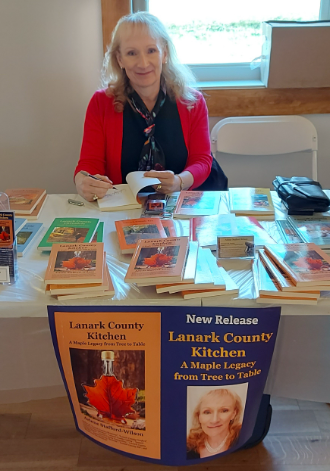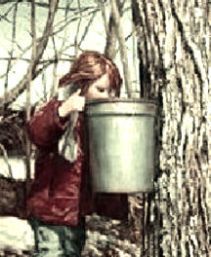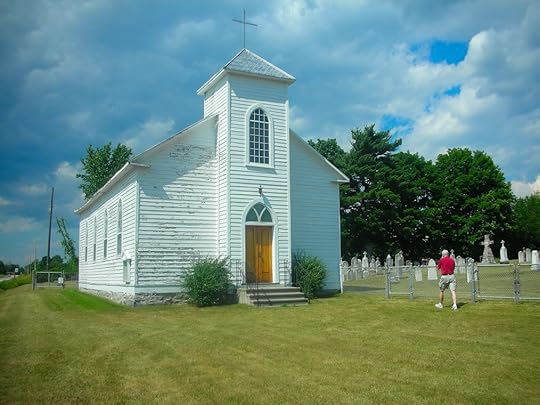Arlene Stafford-Wilson's Blog, page 10
April 18, 2024
Almonte’s Distinguished Homes -1982
In the spring of 1982, the Almonte General Hospital Auxiliary organized a fund-raising house tour, of some of Almonte and area’s most distinguished homes.

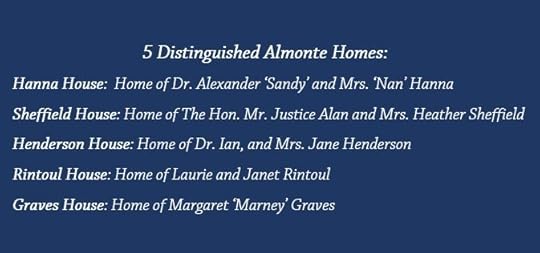


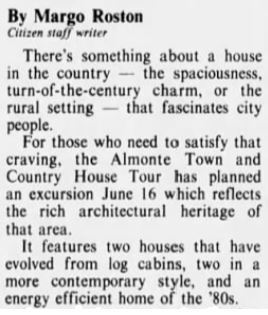
“The 750 tickets printed for the tour sold out in record time,
weeks before the tour date of June 16th.”
It was the first time in the history of the Almonte house tours that the tickets sold out so quickly. The cost was $8.00, and the proceeds were to help the building fund for the Almonte General Hospital.

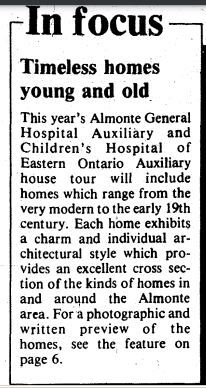

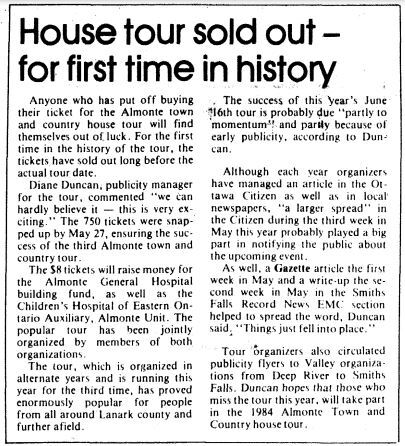
Hanna House
The Hanna House – was on Highway 29, just outside of Almonte, and the property owners were, Dr. Alexander ‘Sandy’ Hanna, (1917-1989), (son of Isaac Alexander Hanna, Millicent Elgey Chesney), and his wife, Ann ‘Nan’ (Dalgity) Hanna), (1919-2008), along with their children, Allan, Brian, and Susan. Ann ‘Nan’ was born in Perthshire, Scotland, and her parents were John Watt Dalgity (1895-1963) and Lizzie Mason Houston, (1892–1979).
“The Hanna House was built in 1981,
with retirement and space for horses in mind.”


“The focus of this bright and cheerful home
is the 26-ft high main floor hallway.”
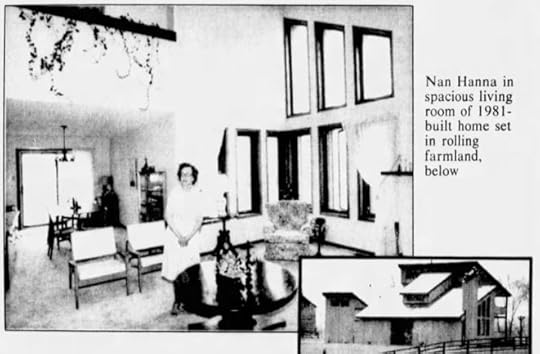
“The 1981-built Hanna home.
set in rolling farmland.”
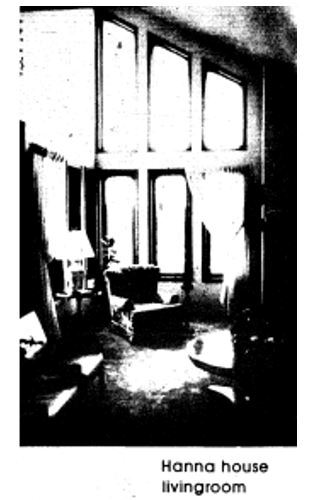
“Custom designed by their son, Brian, a Regina architect.”
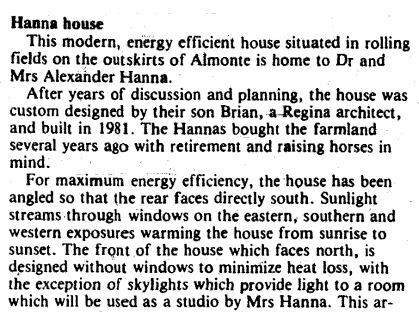

Sheffield House
Sheffield House owners: Judge Alan Sheffield, son of James Garfield ‘Shep’ Sheffield and Viola (Mullin) Sheffield of Arnprior, and Heather (Jardine) Sheffield, their children: Jennifer, Sarah, and Emily.
“Built in 1966, the four-bedroom home, with a pool,
features interesting decor.”

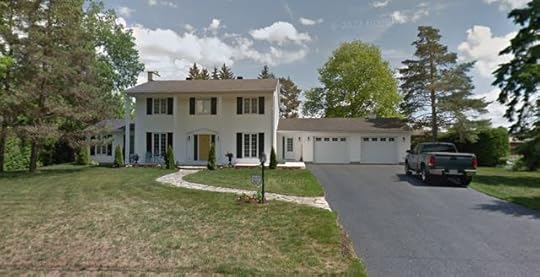
“This comfortable modern Georgian style house
is home to Judge and Mrs. Sheffield,
and their three daughters.”
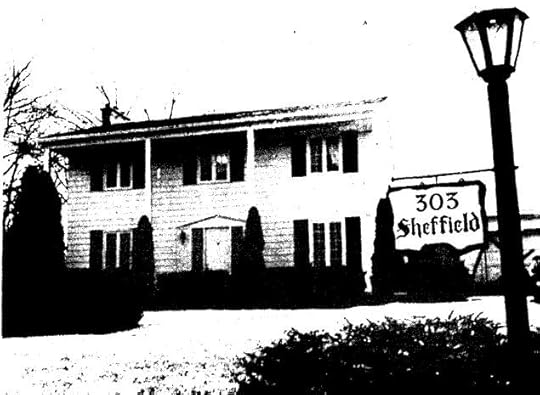


Henderson House
(also known as Glenelvin Farm)
Dr. Ian Henderson, (1928-2006) and his wife, Jane (Mitchell) Henderson bought Glenelvin Farm in Ramsay Township in 1973. Dr. Henderson was born and educated in Glasgow, Scotland
“This rambling country home was built in 1836,
with additions completed in 1890.”


“At the end of a long lane
lined with century old cedars, is Glenelvin.”
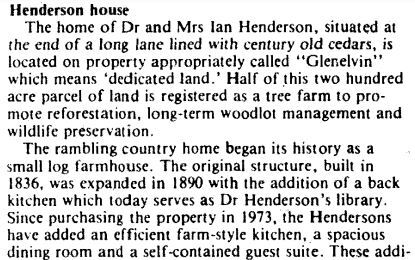
“The rambling country home began its history
as a small log farmhouse.”

Rintoul House
The Rintoul House was located along Highway 29 to Pakenham, near the Cedar Hill turn-off, and the property owners were Laurie Winston Rintoul, and his wife, Janet Ray (Anderson) Rintoul.
Background: Laurie’s parents were George Alva Rintoul and Helen Elizabeth Somerville. Janet’s parents were John Anderson and Irene Hargreaves.
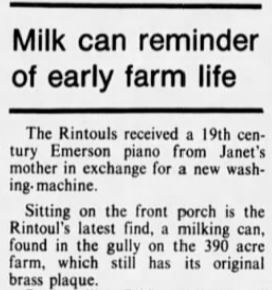
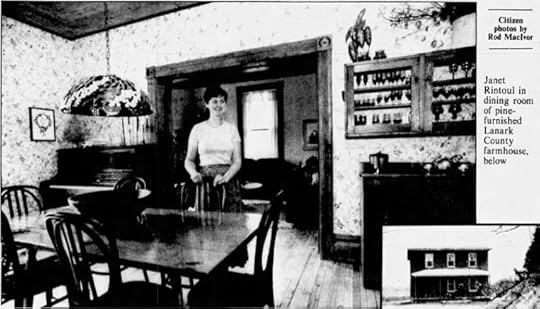
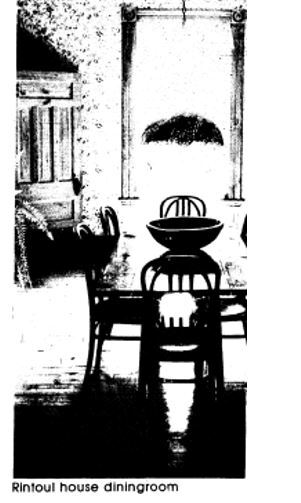
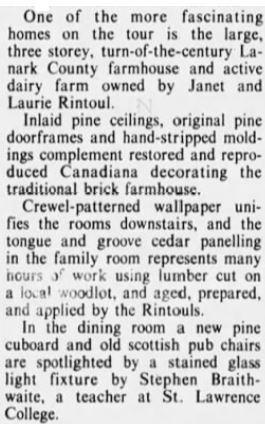
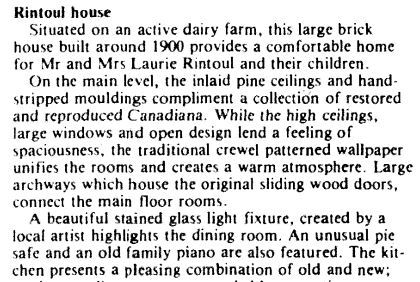
“The tongue and groove cedar paneling
represents many hours of work
as the lumber was cut on a local woodlot,
aged, prepared, and applied by Mr. Rintoul.”
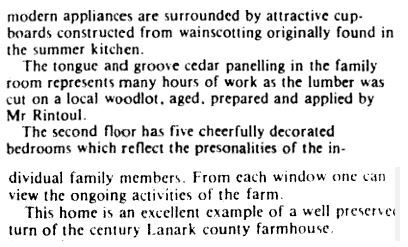
Graves House
“Marney Graves, (1919-2014), purchased
the log house in 1978 for $1,750,
and began extensive renovations.”
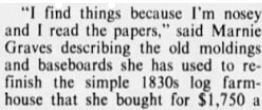
“Graves, a decorating consultant,
has restored and refinished most of the interior
of the old log cabin herself.”
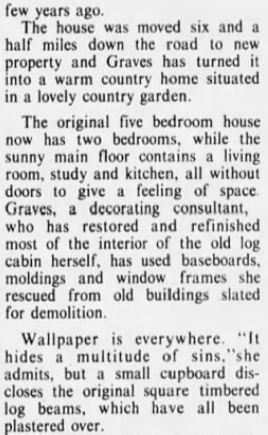
Marny Graves was a well-known Decorating Consultant,
and beautified homes in both Almonte and Ottawa.
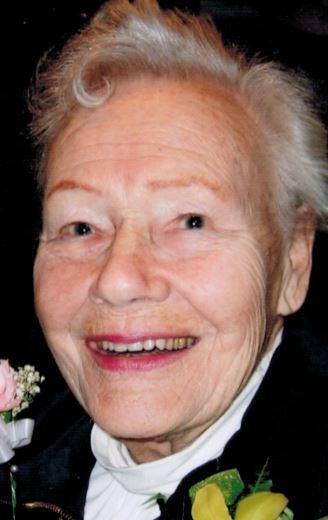
Margaret ‘Marny’ (Hardwick) Kemp Graves, born in London, England, daughter of William Hardwick, and was married in 1952, to George Garland Graves (1916-1973). Marny came to Canada in 1947, and worked in the advertising department at the “Ottawa Journal” for 15 years. She worked for 10 years as the Decorating Consultant and Curator at Laurier House, a Victorian mansion in downtown Ottawa, and former residence of Prime Minister William Lynon Mackenzie King. In 1974 she was on site at Laurier House for the celebration of the 100th anniversary of Mackenzie King’s birth.
In an article about the 100th Anniversary celebrations at Laurier House, Marny spoke about the collection, and of Mackenzie King, “You can almost feel him in some of the rooms.”, “The third floor study was Mr. King’s favourite room”
According to the article: “He would work at every opportunity from the study rather than his Parliament Hill office. On every available ledge and wall area there are photographs, paintings, statuettes and other keepsakes collected by the bachelor Prime Minister. According to Marny, “It was what one might call organized clutter.”
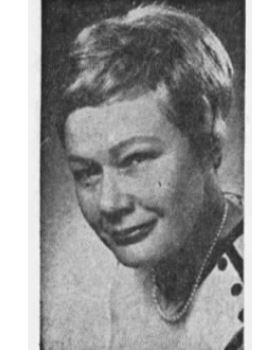
Marny Graves, while she was the Advertising Manager for Armstrong and Richardson
From there, she secured a position with Armstrong and Richardson Shoe Stores, and was the Advertising and Display Manager, responsible for store decor. In the 1980s, Marny worked as the Advertising Manager for Neta Clarke Real Estate, where she specialized in decor, specifically preparing a house for sale so it was more attractive for prospective buyers, what later became known as ‘staging’ a house.
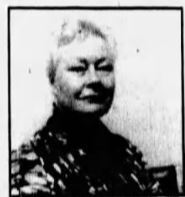
Marny Graves – during her career with Neta Clarke Real Estate
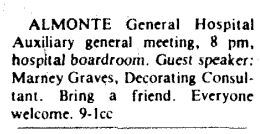
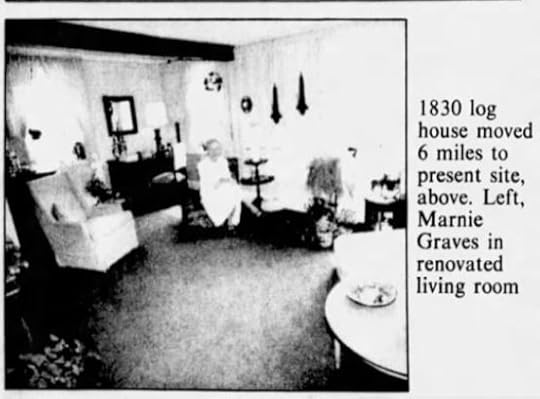
The five-bedroom home was converted to a two-bedroom house
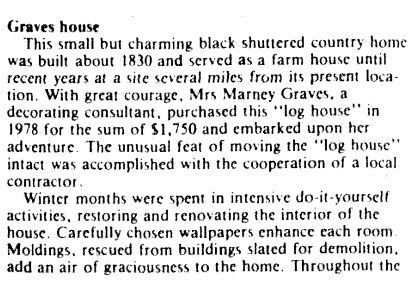

Sadly, Marny Graves, age 94, passed away at the Almonte Country Haven, on September 16, 2014.

The Almonte House Tour of 1982 was surely one that stands out as an event featuring some of the areas loveliest and most stately homes.
I wonder who lives in these beautiful houses today, after many decades have gone by?
Please comment below with your memories and thoughts on these lovely homes.

Sources for Almonte’s Distinguished Homes – 1982:
Article on 100th Anniversary Celebrations at Laurier House, Ottawa – “The Ottawa Citizen”, Dec. 14, 1974, p. 25
Clippings from “The Almonte Gazette” , May 5, 1982, p. 6 and
“The Ottawa Citizen”, Saturday, May 15, 1982, p. 79
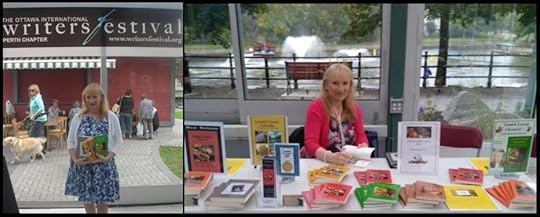
Arlene Stafford-Wilson
Member, Association of Professional Genealogists
Honorary Life Member, Lanark County Genealogical Society
Lanark County Pioneer Family Humanitarian Award
Author of : “Lanark County Christmas”, “Lanark County Comfort”, “Lanark County Collection”, “Lanark County Calling”, “Lanark County Classics”, “Lanark County Connections”, “Lanark County Calendar”, “Lanark County Chronicle”, “Lanark County Kid”, & “Recipes & Recollections”, and “Lanark County Kitchen: A Maple Legacy from Tree to Table”
April 17, 2024
Tatlock Memories
Darling township, Lanark County, with localities including Tatlock, White, and Marble Bluff, was named in 1822 for a military officer, Major General H. C. Darling. He was a colonel serving as the military secretary to Canada’s Governor General. Darling Township was surveyed in 1822 for the influx of Scottish lowland settlers, as well as former soldiers disbanded after the War of 1812 who would be given land grants in this area. Tatlock, is located in what was known as the ‘rocky north’ of Darling Township.
Historic Darling Township Post Offices
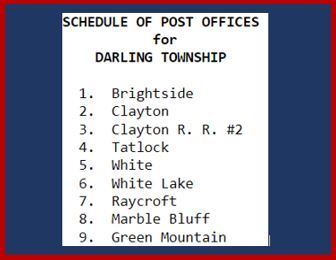
Tatlock, Lanark County

Google map – showing Tatlock and neighbouring communities
Tatlock Hall Opened – 1939
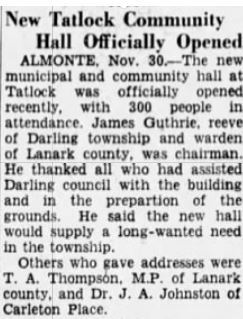
“The Ottawa Citizen”, Dec. 1, 1939, p. 7
The Tatlock Hall was built in 1850, originally a Presbyterian Church, near Brightside, on the French Line. By 1914 the church was closed.
In 1939 the building was torn down and rebuilt at Tatlock, to be used as a community hall. At the time, some believed that the cost to rebuild it, $300.00, would bankrupt Darling Township. Many years later, the hall was loaded onto a flatbed and moved again a short distance. Many upgrades and renovations have been added over the years, such as a new roof, insulation, a new kitchen, and decks off the washroom and kitchen.
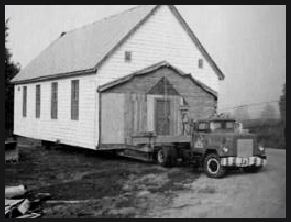
Tatlock Hall
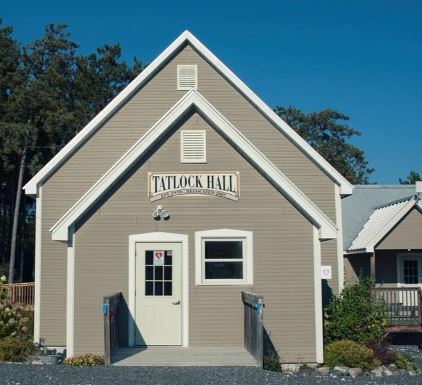
Tatlock Community Hall

Festival of Small Halls concert, at the Tatlock Hall, in 2017
Tatlock Marble Mine

Omega Marble Tile and Terazzo, opened in April 1963, in Tatlock, Darling Township, Lanark County. High quality marble, named “Rideau Blue”, “Rideau White”, and “Princess Blue” was in great demand, and was used on many distinguished buildings of that time.

Some of the members of the original 1963 Omega crew: Steve Bennett, Clydesville, Bert Wark, Tatlock, Bernard Nichols, Calabogie, Bob Neilson of Clydesville, and Ivan Wark, Tatlock.
Beaton Family
Remains Discovered
During excavations at the Omega mines in 1963, several old graves were unearthed, containing the remains of a pioneer family: John Beaton, one of the early teachers and farmers in the area, along with his wife, Janet (Paton), daughter, Helen, son, Thomas, and an unnamed child, who likely died at birth.
The grave marker indicated that the mother, Janet Beaton, was buried in 1903, at the age of 83, so the family were believed to be early settlers to the area. Bob Neilson of Clydesville levelled off the grave at the Omega mine, and the families remains were moved to the Hopetown Cemetery, where a gravestone was erected in their memory.
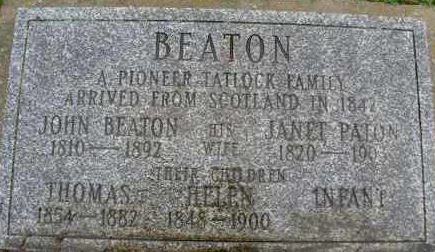
Families of Tatlock
Some of the early families of Tatlock: GUTHRIE, SCHAULER, CRAIG, FAY, RINTOUL, GUNN, WARK, CALDWELL, BARR, BUFFAM, MCILRAITH, MURRAY, CAMELON, MCDOUGALL, SMITH, FLEMING, SWEENEY, STEWART, BURNS, CRAWFORD, MAJAURY, BETELL, BEATON, RAYCROFT, PRETTY, TRAILL, JORDAN, LALONDE, LAROQUE, MAJORE, FOY, CARDINAL, RANGER, PERRY, MCFARLANE, BALLANTYNE, ELLIOTT, CAMELON, FRANK, VIRGIN, BRADFORD, LEE, PENMAN, KING, RABB, LANGSTAFF, WATT, BLACK, MUNRO, MCGEE, MCNEIL, LETT, PROCTOR, KILGORE, MCINTYRE, ROBERTSON, ABRAM, BOYLE, KINGSTON, SMITHSON, SPINKS, ROYCE, BARRIE, RING, MANARY, WHITE.
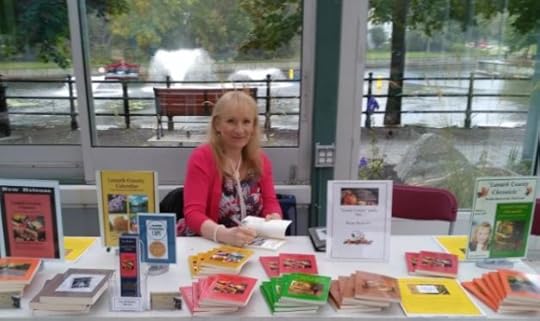
Arlene Stafford-Wilson
Member, Association of Professional Genealogists
Honorary Life Member, Lanark County Genealogical Society
Lanark County Pioneer Families Humanitarian Award
Author of : “Lanark County Christmas”, “Lanark County Comfort”, “Lanark County Collection”, “Lanark County Calling”, “Lanark County Classics”, “Lanark County Connections”, “Lanark County Calendar”, “Lanark County Chronicle”, “Lanark County Kid”, & “Recipes & Recollections”, and “Lanark County Kitchen: A Maple Legacy from Tree to Table”
April 15, 2024
Oliver’s Maple Tarts
Featured in, “The Lanark Era”:

September 12, 2023, p. 13, “The Lanark Era”
Heritage Maple
This recipe comes from the Oliver family, one of Lanark County’s heritage maple farms.
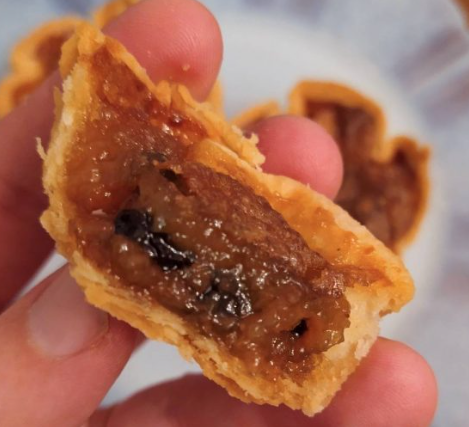
Maple syrup has been produced at the Oliver farm going back to 1827, when George Oliver (1787-1845), native of Roxburghshire, Scotland settled on Concession 8, Lot 25, of North Elmsley Township.

Award-Winning
Maple Syrup
Through the years, the Oliver family has produced award-winning maple products. In 2016, David and Tressa Oliver, and their cousins, Richard and Jay Hendry shared in the prestigious Sugar Maker of the Year Award.

photo: Oliver’s Mapleworks website
150-Year
Legacy Farm
In the same year, the Oliver’s property was designated as a 150-Year Legacy Farm, as part of the 200th anniversary celebration of the Perth Military Settlement.
Today, Oliver’s Mapleworks produces maple syrup, soft maple sugar, maple butter, and they also invite the public to enjoy scenic wagon rides, and tours of their sugar camp.
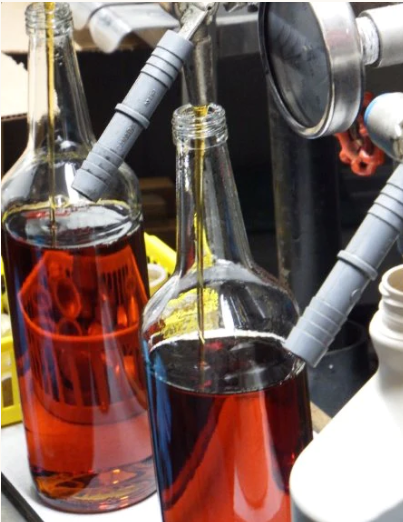
photo: Oliver’s Mapleworks website
Oliver’s Mapleworks

Oliver’s Mapleworks
158 Lakewood Lane,
Perth,
Ontario K7H 3C7
Phone: 613-264-8612
If you are using a GPS,
please be sure to enter 158 Lakewood Lane, Drummond/North Elmsley Township
rather than Perth.
Oliver’s Mapleworks website:
https://www.oliversmapleworks.com/
Discover the stories and the heirloom recipes of our Lanark County Maple Syrup Producers in “Lanark County Kitchen: A Maple Legacy from Tree to Table”
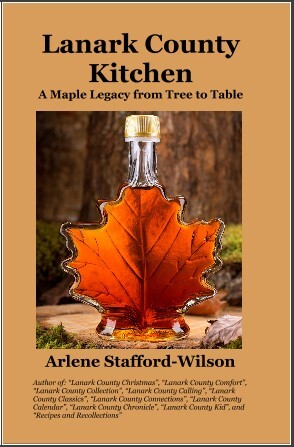
Arlene Stafford-Wilson
Honorary Life Member, Lanark County Genealogical Society
Member, Association of Professional Genealogists
Lanark County Pioneer Families Humanitarian Award
Author of : “Lanark County Kitchen”, “Lanark County Christmas”, “Lanark County Comfort”, “Lanark County Collection”, “Lanark County Calling”, “Lanark County Classics”, “Lanark County Connections”, “Lanark County Calendar”, “Lanark County Chronicle”, “Lanark County Kid”, & “Recipes & Recollections”
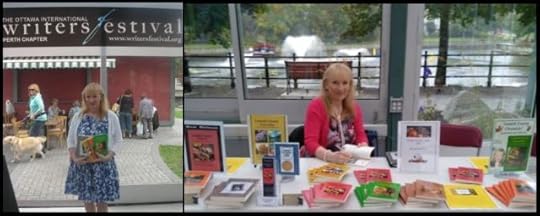
April 14, 2024
Festival of the Maples
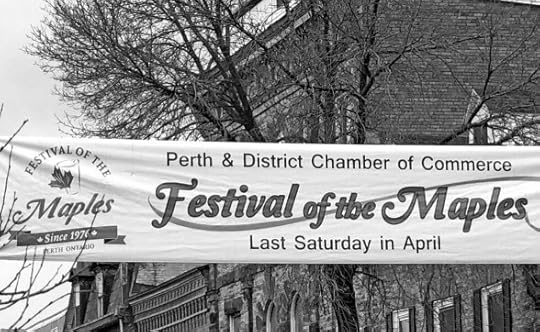
With a variety of vendors, live entertainment, and the finest tasting maple syrup produced in the world, the Festival of the Maples in Perth is the place to be every year following the maple syrup harvest.
The very first maple festival was held back in the 1970s.
The story that follows is dedicated to the Lanark County families who played such a significant role, back in the early days, leading up to this annual festival in Perth: Andrew and George Korry, Bowes family of Glen Tay, Ernie and Evelyn Miller family of Glen Tay, Robert McEwen of Prestonvale, Ken VanAlstine of Maberly, Leonard and Tom Adam of McDonald’s Corners, Brien and Marion Paul west of Hopetown, Lanark, James ‘Carman’ and Edna Gibson of Dalhousie Township, Don and Marion Dodds of Clayton, George Coutts of Rideau Ferry, Wheeler family of McDonald’s Corners, and Fulton family of Pakenham to name a few.
Taffy on the TayYears ago, many of the local farmers produced maple syrup. Some just made enough for their families and for some it was a supplement to their farm income at a time of year that was less busy than during the summer months. There were also a few dealers in the area that sold sugar bush supplies – Max Miller of Snow Road, Percy Drysdale of McDonald’s Corners, and W.J. Ballantyne in Lanark. James Brothers Hardware and the Co-Op also sold supplies for maple production. Labels for the bottles were often printed by ‘The Perth Courier’.
The Korry family across the road from us had a medium sized sugar bush and they produced not just enough for the family, but enough to sell locally. Andrew’s son-in-law John Chaplin sold it through his dairy to the local customers on the milk routes. Andrew Korry and his son George spent a few very busy weeks making syrup each spring and my brother Tim worked with them in the bush one year. They used a team of horses with a tank mounted on the sleigh to draw the sap back to the evaporator at the sugar shack; typical of many other producers at that time.
The Bowes and the Miller families near Glen Tay also produced their own syrup. I remember that Art Bowes used to tap quite a number of trees in the mid-sixties. Their farm was known as Tayview farm and it straddled the Tay River and was very picturesque. At that time they had about 300 acres which included hay fields, pastures and of course maple bushes. His son Doug was on our school bus and he used to talk about helping his Dad back in the bush each spring.
The Miller family’s farm, known as Tayside was owned by Ernest ‘Ernie’ Miller and his wife Evelyn (Mather). The Miller family arrived from Scotland in 1809 and their farm was purchased by Ernie’s great grandfather Dodds in 1858. Their kids were Diane, Nancy, John and Ruth. Evelyn was a lovely, soft-spoken lady and she was my first 4H club leader. I also remember that Ernie was tapping about 1,500 trees back in the sixties and had about 30 acres of maple woods. Ernie was a forward thinker and one of his ideas at that time was that sap should be gathered by trucks from each farm and taken to a large central evaporator – similar to the way that milk was trucked to cheese factories. It seemed through the years that Ernie was into everything. When he wasn’t farming he wrote history books, he researched genealogy, he worked with young people and it was no surprise to me when he was inducted into the Ontario Agricultural Hall of Fame in 2003.
The McEwen clan in Ferguson Falls was another family who made their mark in the maple syrup business back in the 60s. In 1966 Robert McEwen of Prestonvale opened up the first pancake house in the area. Originally, Robert made his syrup the old fashioned way out in the bush and boiled a cauldron of sap over the fire. Later, in the 1970s I remember that he was one of the first to use plastic pipelines to bring the sap from the trees to one main location. Dad knew the McEwen family well, having grown up in that area and said that Robert often spoke of the difficulties involved in syrup production. There were always problems like getting reliable labour and often the lack of capital to purchase new equipment. Robert was very active in the local industry and at one time was the President of the Lanark and District Maple Syrup Association.
Ken VanAlstine in Maberly had over 2,000 trees tapped when I was a kid and he was among the first to use pipelines. He experimented at first and tapped just 200 trees using the pipeline system but the rest was collected in buckets the traditional way and transported to the evaporator by horse and sleigh.
Ken, like other producers in the area found the cost of hiring labour prohibitive and that distributers wanted too much money per gallon. Ken was well known in the area for his excellent quality maple syrup and said on his best day at that time he gathered 3,300 gallons of sap.
Another local family of producers was the Adam family of McDonald’s Corners. Leonard Adam and his brother Tom tapped an average of 2,250 trees and had about 500 acres of land between them. They were hard workers and spent many days sawing, chopping and stacking the 20 cords of wood required for their evaporator and were one of the first to use a brand new style of evaporator which was 4 by 14 feet. They produced enough to sell locally and the remainder was shipped out West.
Brien and Marion (McLaren) Paul of R.R #3 Lanark had a 575 acre farm about three miles west of Hopetown and began maple production in 1953. Marion was raised on a farm near the village of Lanark, was known locally as the ‘First Lady of Maple’ and became a maple judge at the Royal Winter Fair in Toronto. Their kids Kathy, Wayne and Darrell were also very involved and provided additional labour for the family business. In 1972 Kathy was even crowned Maple Queen in the local competition.
Back in the 1960s they used two sleighs, one pulled by a tractor and the other by a team of horses. Brien’s father Raymond Paul often tended the evaporator, keeping a watchful eye as the steam boiled off into the air. Russell Foster and Raymond Watt often assisted the Paul family with the production. They tapped an average of 4,000 trees at that time and produced about 700 gallons of syrup and used approximately 30 cords of wood during the season.
The Paul’s were pioneers in the maple industry and were very modern in their approach. They were one of the first to install plastic tubing and an oil fired evaporator. The plastic pipes were attached to the tree spiles and the sap flowed through the pipes and emptied into a storage reservoir located behind the evaporator. Brien and Marion were inducted into the International Maple Hall of Fame and were members of the Ontario Maple Producers and the Lanark and District Maple Producers Association.
Gibson was a name known for their excellent syrup. James ‘Carman’ Gibson and his wife Edna (Rodger) had a maple business in Dalhousie Twp at R.R. # 4, Lanark. The nearby areas of Hoods and Poland were also known for their fine quality maple syrup. The Gibson family began tapping trees in 1821 with the arrival of James Gibson from Lanark, Scotland. He was the first pioneer settler in the area and named their new home Lammermoor after the Lammermoor Hills in Scotland. Their five children Verna, Beatrice, Norma, Carol and Earl all helped out with the operation. They also raised beef, dairy on their busy farm and hauled milk to the Middleville cheese factory.
When locals think of a long running maple operation, the name Dodds comes to mind. They had a substantial sugar bush at R.R. 2 Clayton in the Lanark Highlands. The Dodds family has owned Springdale Farm for generations and Don and Marion Dodds and their sons Bryan and Stephen helped with production through the years. The family has won many awards for being long term maple producers and as recently as last year Stephen Dodds won Grand Champion Trophy at Perth Festival of the Maples for 2011. Their long, long, list of awards include trophies for World Champion Maple Syrup, Sugar Maker of the Year, and a meeting with HRH Prince Charles at the Royal Winter Fair.
One of the maple syrup families that I remember fondly was the Coutts family on the Rideau Ferry Road. I’ll never forget how George Coutts used to invite the local kids to visit his sugar shack and he would take the time to patiently explain how the maple syrup was made. Miss Norma Devlin from the North Elmsley School was invited each year to bring her grade one class to visit the Coutts farm. George along with his son Kenneth showed the children how syrup was made and even provided the kids with some maple taffy at the end of the tour. At that time the Coutts family was tapping about 1,300 trees and produced more than enough syrup for both the family and for area sales.
The ancestors of the current Fulton family began to tap their maple trees back in the 1840s. Their large 370 acre farm is located between Almonte and Pakenham and they have tapped their huge 4,000 tree sugar bush for generations. Well known for their high quality syrup they have also operated a pancake house for many years and their sugar camp has been a popular attraction for both area families and visitors.
With these and so many other excellent producers in Lanark County, it’s not surprising that back in the 1970s there were talks of having a maple festival in the town of Perth. It was Vic Lemieux, owner of Norvic Lodge at Christie Lake, who first came up with the idea and presented it to the Perth Chamber of Commerce. Vic was successful in his campaign to launch the first festival, with the hopes that it would bring people out to celebrate the spring season after a long, cold, winter.
On April 19, 1975 the very first Festival of the Maples was held in Perth and it was quite an event!
When we arrived at the Festival that Saturday, they had closed part of Gore Street and Foster Street and the local maple vendors had set up their displays. At 10 a.m. the Festival was officially opened by the Ontario Minister of Industry Claude Bennett. The Legion ladies and the ladies from St. Andrew’s church had home baking for sale, and there were also side-walk sales on Gore Street and many arts and craft exhibits.
There were a tremendous number of district producers and many of them offered syrup for sale in various sized containers. Pancakes were available for purchase and free samples of Balderson cheese were given away and I recall we went back a couple of times to that booth! One of the oddest things was to see a wood burning evaporator set up on one of the main streets of Perth. I’ve seen a few of those out in the bush, but I never thought I’d see one in town!
Fiddling and step-dancing competitions were held that year and I remember Dawson Girdwood saying that some of the best fiddlers from Eastern Ontario were competing in the open and junior fiddling classes. Jimmy Heney, one of our neighbours won the fiddling prize hands down, as he often did and Karen Grey of Perth was the top step-dancer that night.
The folks in Perth were always up for a good beauty competition and so part of the evening program at the arena that night was the crowning of ‘The Sweetest Girl in Lanark County’. Miss Perth 1975 Michelle Hughes crowned the winner, Maple Queen Susan Thompson of Perth.
Over the years we always attended the Festival and each spring it seemed to grow by leaps and bounds. Every year it seemed that there were more vendors selling their maple goods, more artisans displaying their crafts and an increasing number of booths and displays. We also noticed a steady growth of tourists who had come from Ottawa, Kingston and even as far away as the States to visit.
People in Lanark County, understandably, have always taken their maple syrup very seriously. Because of this, it was devastating to many when January of 1998 brought the most destructive ice storm in Canadian history. From January 4th to 10th Lanark County was severely affected by freezing rain and ice pellets that fell and accumulated on tree branches day after day. This ice created a thick, heavy coat, damaging both the maple trees and the pipelines in the sugar bushes. Millions of tree branches were caked with the build-up of ice and became so heavy that they split right off of the trees; severely affecting the sap flow. At the time, there were speculations that it could take forty years for production to return to normal.
Many of us, have participated in making maple syrup at one time or another and know from experience that it’s extremely labour-intensive. We also have a clear understanding of the enormous amount of sap it takes to make a very small quantity of syrup. No matter how modern the equipment or methods, it still takes forty gallons of sap to make one gallon of syrup.
Now, add in the hours of labour for the tapping, transporting from the tree to the evaporator, the boiling down, the straining, the bottling and the labeling. Next, factor in the cost of equipment such as the spiles, the pails or tubing, the evaporation tank, fuel, the straining equipment, the bottles, cans and cost of transporting to market. All things considered, today’s prices don’t sound that bad anymore.
So, the next time you pass by the maple syrup display in the grocery store aisles, or visit a maple vendor at his farm or at a festival, please remember how it’s produced. Remember the proud, hard-working families who settled in Lanark County and passed down their knowledge through the generations. Think of the enormous quantity of sap required to make a very small container of syrup. Most of all please stop and consider the origin of your syrup and take it from this Lanark County kid – you won’t find any better, more flavourful syrup, than from the Maple Syrup Capital of Ontario.
(this story is an excerpt from “Lanark County Chronicle: Double-Back to the Third Line”,
ISBN 978-0-9877026-2-3 )
.
Arlene Stafford-Wilson
Honorary Life Member, Lanark County Genealogical Society
Member, Association of Professional Genealogists
Lanark County Pioneer Families Humanitarian Award 2023
Author of : “Lanark County Kitchen”, “Lanark County Christmas”, “Lanark County Comfort”, “Lanark County Collection”, “Lanark County Calling”, “Lanark County Classics”, “Lanark County Connections”, “Lanark County Calendar”, “Lanark County Chronicle”, “Lanark County Kid”, & “Recipes & Recollections”
April 13, 2024
McEwen’s Maple Baked Beans
Robert McEwen’s Pancake House, in Ferguson Falls, was the first of its kind in the region. It began as a centennial project, opened in 1967, with the intention of providing jobs for local youth.
Through their decades of operation, Robert and Kaye McEwen did indeed employ not only dozens of local youth, but many others from the community, both in the sugar bush, and the pancake restaurant.
“Local legends say that Dorothy Horricks, who lived next door to the McEwen’s, and worked at their restaurant, likely cooked at least one million pancakes over the years.”
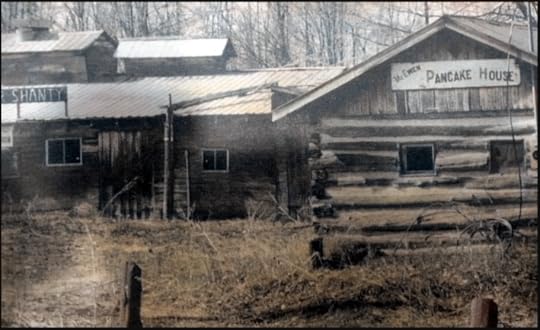
McEwen’s Pancake House, Ferguson Falls (1967-1993)
Although the ingredients are simple, this recipe became a well-loved and much in-demand dish at McEwen’s Pancake House, over the years.
“Maple syrup was used extensively by my mother, in all kinds of dishes, and her baked bean recipe was very popular.” Tom McEwen
Kaye (Huckabone) McEwen’s
Maple Baked Beans
Ingredients
3 c beans
1 tsp mustard
1/2 c maple syrup
1 tsp salt (if desired)
1/2 c butter
1/4 c tomato ketchup
Method:
Cover beans with water, and simmer for 2 hours.
Add mustard, maple syrup, salt, butter, and ketchup
Put in a baking dish and cover with water
Bake in a slow oven for several hours
Add more liquid as needed
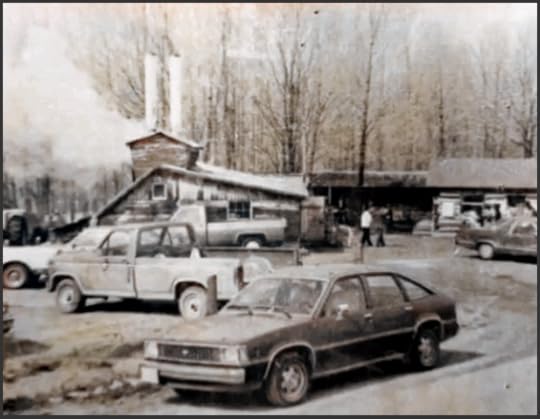
McEwen’s Pancake House and Sugar Bush
“Bob McEwen was one of the first maple producers in the area to install pipelines in the sugar bush, and he installed them for the 1968 season.”

Robert ‘Bob’ McEwen was a trailblazer in the close-knit community of maple syrup producers, and was continually embracing new methods and upgrading his equipment in order to achieve the highest possible standards of sap collection and processing.
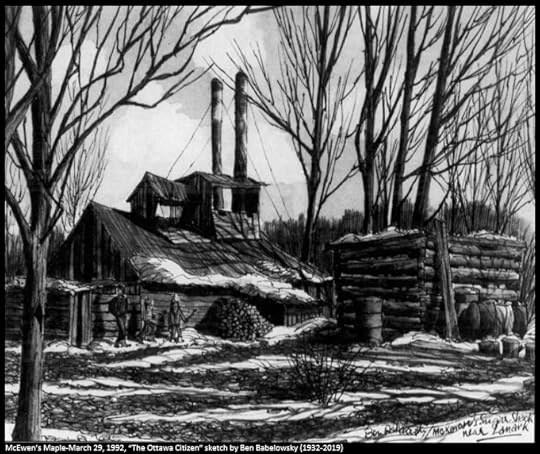
To commemorate the 25th Anniversary of McEwen’s Pancake House in 1992, – local artist, Ben Babelowsky (1932-2019) created an impressive work of art depicting the McEwen property, capturing this special moment in time.
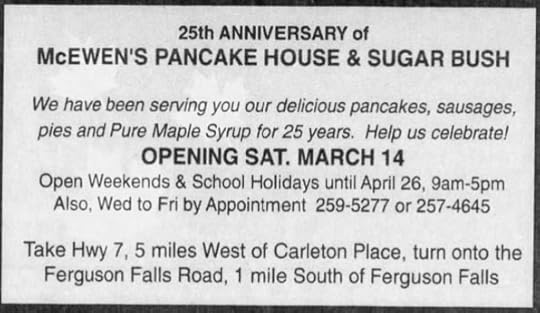
Mar. 11, 1992, p. 14, “The Ottawa Citizen”
Some of the surnames of the people (and youth) who worked at McEwen’s over the years:
Horricks, Beekman, Blair, McNaughton, Quinn, Ennis, Campbell, Mitchell, Hodgins, Lindenstruth, Closs, Bruneau, Eschke, Morris, Crosbie, Brittain, Couch, Dickenson, Vanderlaan, Badour, Hollington, Kelford, MacLaren, McCullough, Stach, Scott, Leuders…..
(The former McEwen’s Pancake House and Sugar Shack is now home to the award-winning Temple’s Sugar Bush……..another story of a legacy maple family, in the new book, “Lanark County Kitchen”.)

Who were Lanark County’s maple trailblazers? Who are the ‘legacy’ maple syrup producers whose families have been making maple syrup and maple sugar since the times of the early settlers?
Coutts, Dodds, Ennis, Fortune, Fulton, James, Oliver, Paul, Temple, Thompson, VanAlstine, Wheeler….
Meet the families with a long history of maple syrup-making, the award-winners, the names you know, the syrup that you love. Discover their stories, from the old days up to the present.
Enjoy the special collection of heirloom maple recipes – some passed down through the generations, and some made popular in their own restaurants…
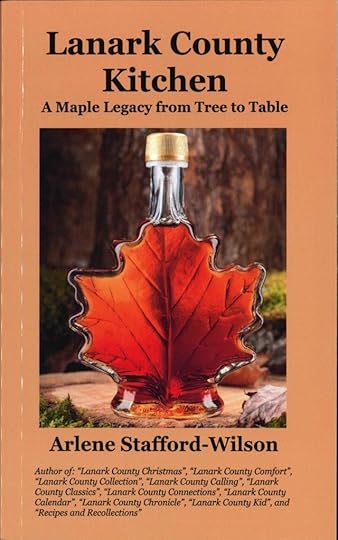
.
.

Arlene Stafford-Wilson
Honorary Life Member, Lanark County Genealogical Society
Member, Association of Professional Genealogists
Lanark County Pioneer Families Humanitarian Award
Author of : “Lanark County Christmas”, “Lanark County Comfort”, “Lanark County Collection”, “Lanark County Calling”, “Lanark County Classics”, “Lanark County Connections”, “Lanark County Calendar”, “Lanark County Chronicle”, “Lanark County Kid”, & “Recipes & Recollections”
and “Lanark County Kitchen: A Maple Legacy from Tree to Table”
March 29, 2024
Mother’s Farmhouse Hot Cross Buns

It just wasn’t Easter weekend until the old house was filled with the rich aroma of Mother’s home-baked Hot Cross Buns! It was a long-standing tradition at our home on the Third Line of Bathurst, although legends say that these mouth-watering buns were made long before any of us were around.
It was way back, in the twelfth century, that an Anglican monk at St. Albans Abbey, first made these buns, marked each with a cross, and distributed them to the poor on Good Friday.
Hot Cross Buns were an Easter tradition at the Stafford house, along with a juicy baked ham, creamy scalloped potatoes, and of course, velvety sweet chocolate Easter eggs.
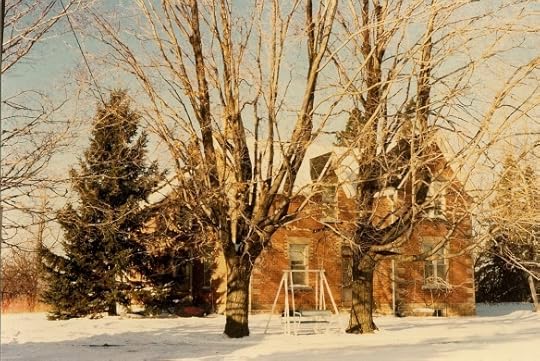
Mother, a keen competitor in the local fairs for many decades, was eventually asked to become a Judge, and her prize-winning baking was a daily treat at our house.
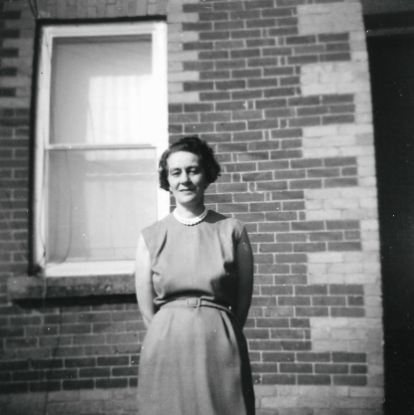
1 c milk
2 1/2 tsp sugar
2 pkt yeast
2 tsp salt
2 eggs (beaten)
3/4 c cold water
7-7 1/2 c flour
1/4 c shortening
2 tsp cinnamon
1/2 c warm water
1/2 tsp allspice
1 c raisins
(1 c chopped peel and 1 c currants if desired)
Mix as for yeast dough, but mix spices with the flour
Stir in the raisins (currants, and peel)
Knead 5 minutes
Let rise until doubled
Divide dough into pieces about 1 1/2″ diameter shape, and place 1 1/2″ apart on a greased baking sheet
Let rise to double
Bake at 350 F
After 15 minutes, remove from the oven and brush with glaze (2 Tbsp water and 2 Tbsp sugar)
Return to oven and finish baking. Brush again with the glaze, and cool
When cool, make a cross on each bun with white icing
Serve with softened creamery butter, or homemade preserves if desired.

Be prepared for the sweet scents of cinnamon and fresh baked bread to fill your home, bringing memories of Easters past, and maybe the beginning of a new tradition in your family!


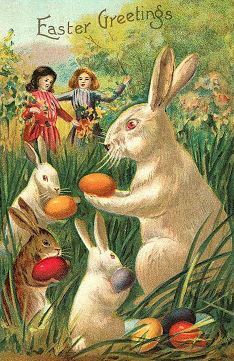
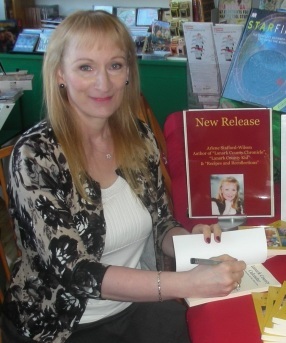
Arlene Stafford-Wilson
Honorary Life Member Lanark County Genealogical SocietyLanark County Pioneer Families Humanitarian AwardMember Association of Professional GenealogistsFor more of Mother’s Farmhouse recipes:
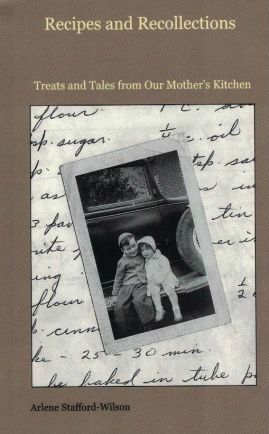
March 27, 2024
St. Augustine’s & Heritage Homes, Prospect
Saint Augustine’s Anglican Church is located at Concession 3, Lot 26, 261 Richmond Rd, Prospect, Lanark County, Ontario, Canada
Built in 1854, by stone mason, John May, on land donated by William James, with lumber and stone supplied by parishioners, St. Augustine’s has a seating capacity of 120, and the church served a group of early Irish Anglican settlers who had been meeting up to that time in a school house.
In 1888 St Augustine’s became part of the Parish of Ashton. St. Augustine’s Church and cemetery were consecrated by Bishop Charles Hamilton on September 24, 1896.
Closed in 1967, the building, cemetery and grounds are maintained by the Ashton Parish. A service is held once a year in August.
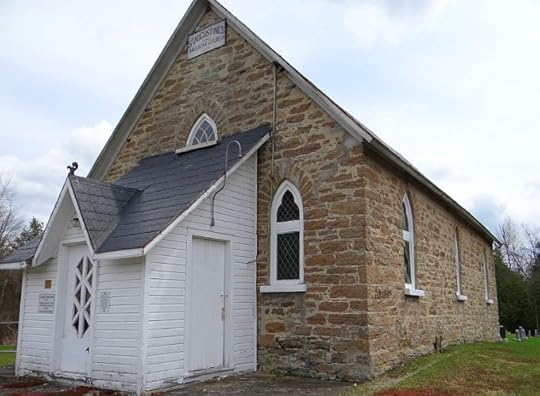
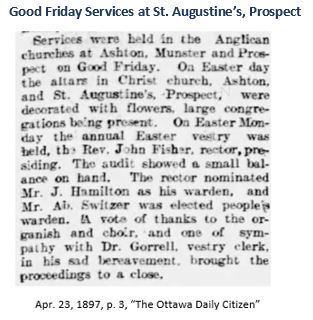
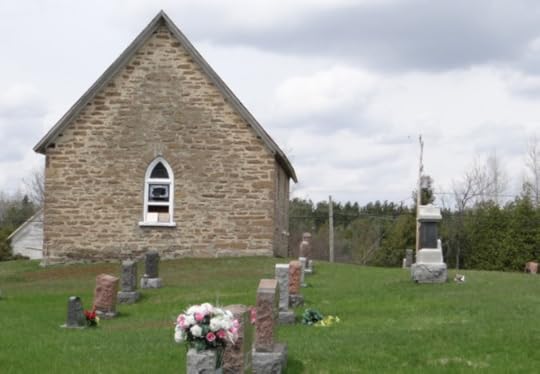
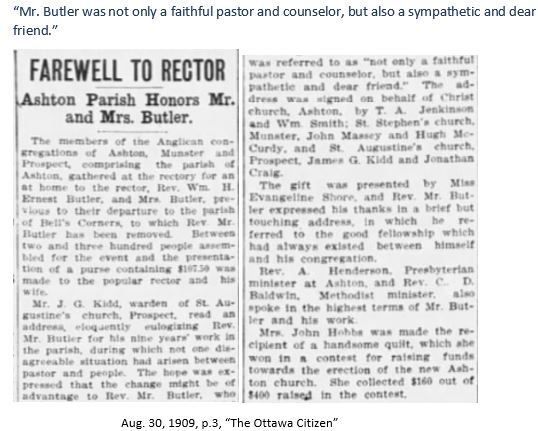
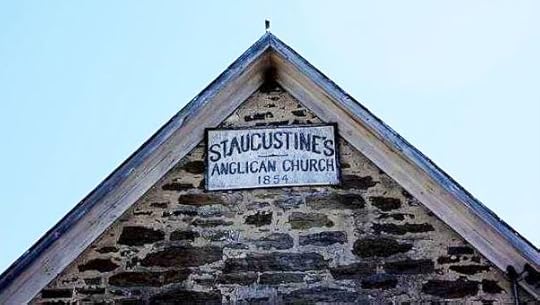
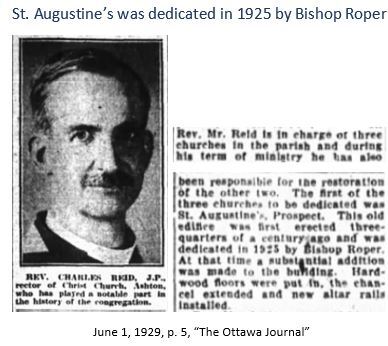

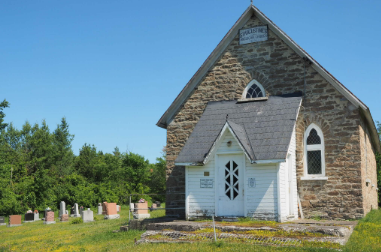

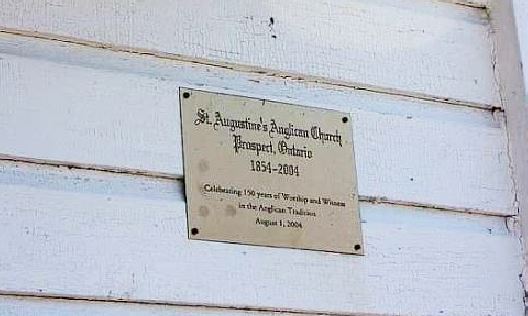



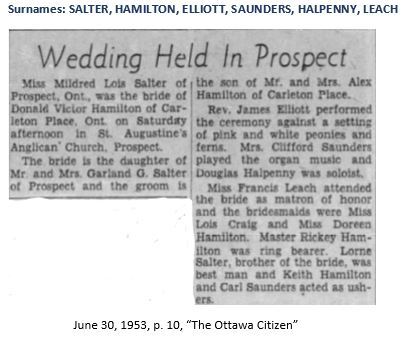
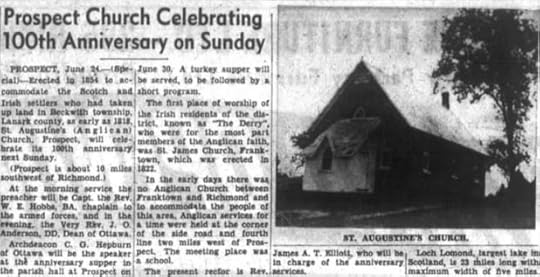
June 24, 1954, p. 12, “The Ottawa Journal”
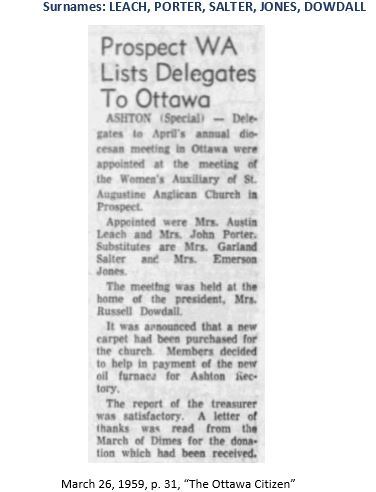
James Family
Heritage Home
This heritage home has changed hands over the years: William James was the original owner. The James family donated the land for St. Augustine’s Church in 1854. John Porter bought the house from a son-in-law of the James family. The home was purchased by Mr. and Mrs. D.B. Rees, who sold it to Arnold and Moira Guetta.

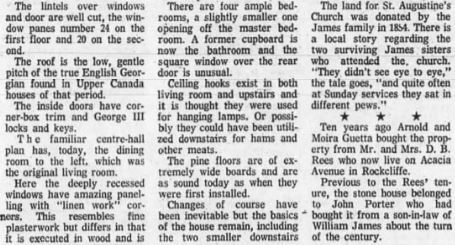
Aug. 19, 1972, p. 31, “The Ottawa Journal”
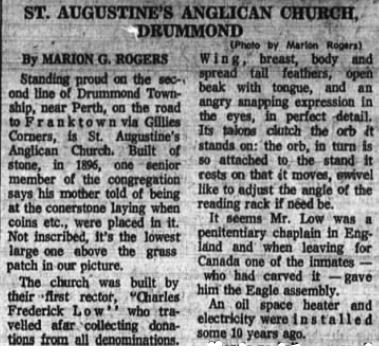
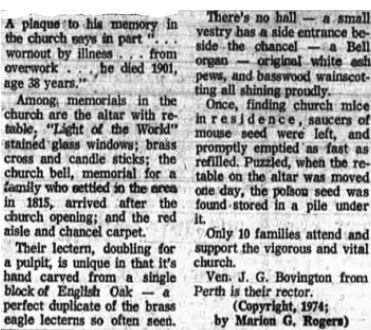
May 4, 1974, p. 42, “The Ottawa Journal”
Prospect Heritage
House Tour 2007
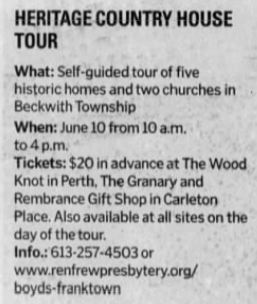
June 2, 2007, p. 88, “The Ottawa Citizen”
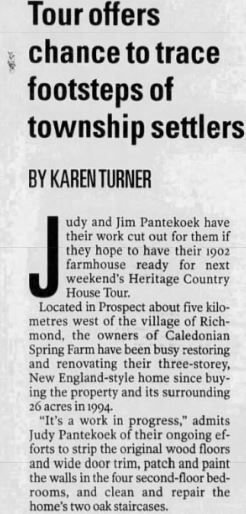
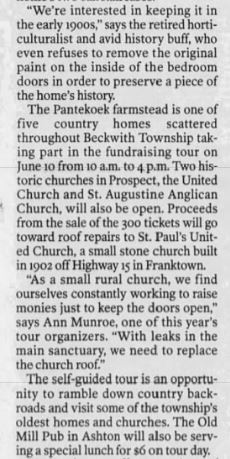
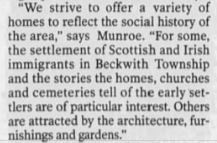
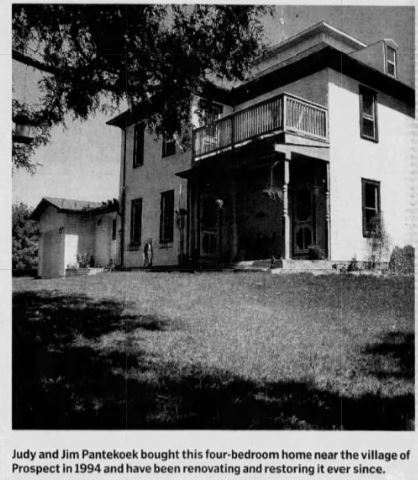
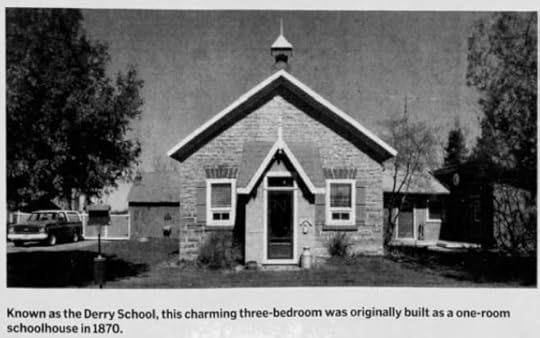
June 2, 2007, p. 88, “The Ottawa Citizen”
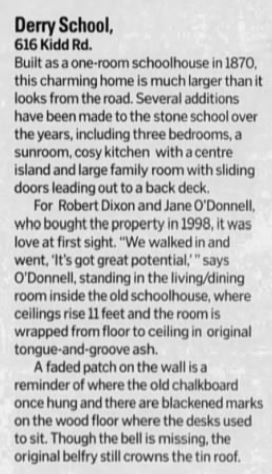
June 2, 2007, p. 88, “The Ottawa Citizen”
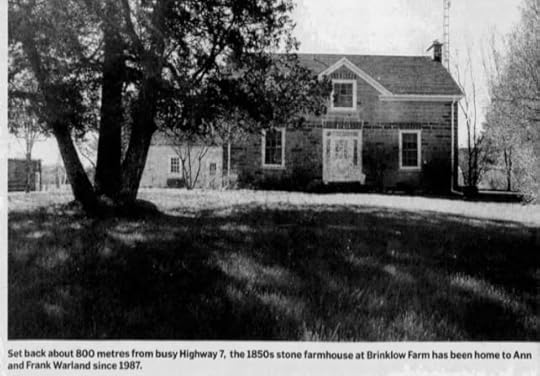
June 2, 2007, p. 88, “The Ottawa Citizen”
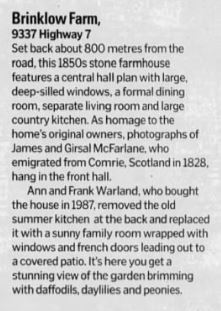
June 2, 2007, p. 88, “The Ottawa Citizen”
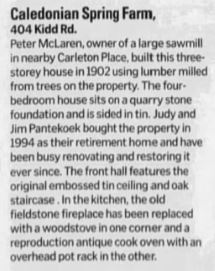
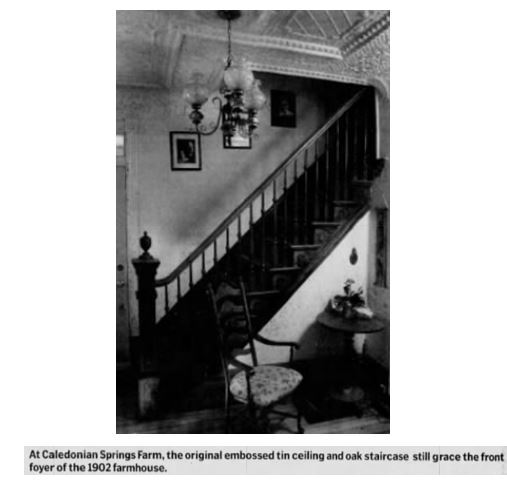

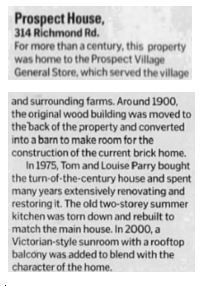
Some of the family names in the area: Bennett, Beveridge, Blair, Boyle, Budd, Carrigan, Cassell, Christie, Craig, Douglas, Dowdall, Featherston, Flinn, Garland, Gladden, Goodenough, Graham, James, Kinsella, Lackey, Leach, Lewis, Makinson, McMullen, Parry, Plant, Plaunt, Porter, Presley, Rathwell, Rothwell, Salter, Saunders, Simpson, Wilson.
Sunday Drive
or Walking Trails
Prospect is surrounded by farmer’s fields, thick forests, and scenic walking trails. One of the nicest trails, Goodwood Marsh Nature Trail begins at the Beckwith Recreation Complex located at 1319 9th Line Beckwith, linking to the Beckwith trail network
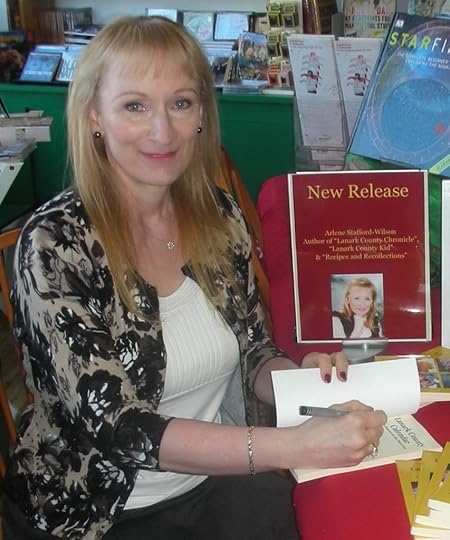
Arlene Stafford-Wilson
Member, Association of Professional Genealogists
Honorary Life Member, Lanark County Genealogical Society
Lanark County Pioneer Families Humanitarian Award
Author of : “Lanark County Christmas”, “Lanark County Comfort”, “Lanark County Collection”, “Lanark County Calling”, “Lanark County Classics”, “Lanark County Connections”, “Lanark County Calendar”, “Lanark County Chronicle”, “Lanark County Kid”, & “Recipes & Recollections”
and “Lanark County Kitchen: A Maple Legacy from Tree to Table”
March 19, 2024
Spring Came Up the Third Line
One of my friends from DeWitt’s Corners said that they’d seen a robin in their back yard, but I hadn’t seen one yet. The only sign of spring that I’d noticed was the steady drip of water, coming off of the old roof, in the late afternoons, when I returned home from Glen Tay School. That meant that the temperature was rising above freezing during the day, so the sap must be running again.
Sure enough, that same day, I saw Dad heading down the lane, toward the Third Line, and he had his carpenter’s auger in his hands. That old thing looked battered and ancient, but it sure did the trick when he needed to tap some trees. We didn’t have a big maple bush like Korry’s, across the road, but Dad always tapped a few trees along the laneway, so that we’d have enough syrup for the family.
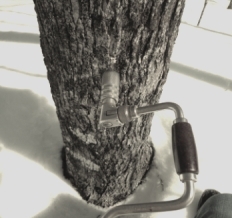
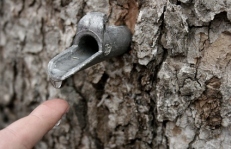
If anyone had bothered to stroll past the trees that we’d tapped, they likely would have laughed themselves silly. It wasn’t exactly a professional operation. None of the buckets matched. We had a grey metal pail, that hung on one of the spiles by a rusty wire. We also had a white plastic bucket, that Mother had made, by cutting up an empty corn syrup jug. Another bucket was made from an empty Billy Bee honey container. We even used one of my old sand pails, that I’d played with on the beach, when we went to Silver Lake in the summer. Any available container was ‘fair game’. It was only for a few weeks after all, and they couldn’t afford to be spending money on something that was used for such a short period of time each year.
Looking back, it didn’t really matter what kind of buckets you used, as long as you had something to collect the sap. I used to stand at the side of the tree, and watch as the clear, sweet liquid dripped ever so slowly, drip, drip, and splashed into the bucket below. I’d lift the bucket off of the metal hook, and dump the sap into Mother’s biggest mixing bowl, hook the bucket back on the tree, and carry the bowl gingerly up the lane way, and into the kitchen. Mother would be ready with a piece of clean cheesecloth, stretched over the big aluminum pot on the stove, and she’d take the bowl of sap, and dump it into the pot. The cheesecloth would catch all of the little specks of dirt, or bits of wood, that had come from the tree, so that the sap in the pot was nice and clean.
I guess if I’d been a little older, and a lot smarter, I would have asked Dad for one of the big pails from the garage, to transport all of the sap, in one trip, into the kitchen. Instead, I emptied one bucket at a time, into the big mixing bowl, and trekked all the way back and forth, up to the kitchen. Up the lane, and down the lane, I went over and over again, until I was finished; usually just before supper time. One night I forgot to empty the buckets, and the next night the sap was overflowing, running down the side of the tree, onto the snow. No one said anything about it, but I felt bad because I hadn’t done my job, and worse still we’d have less syrup because of it.
The air in the old kitchen smelled sweet for those few weeks each year, as the sap boiled away on top of the stove. Usually by the third or fourth day we’d have enough for a little bowl of syrup for dessert. The first syrup of the year was always the lightest in colour and in flavour, perfect for eating straight out of the bowl. Dad liked to pour a little cream into his syrup, and give it a stir. He’d take a piece of day-old homemade bread and dip it into his creamy syrup mixture, until he was down to the last sweet drops, and then he’d do one last sweep of the bowl with his bread.
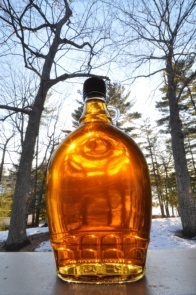
The other kids in the family poured their syrup over vanilla ice cream, but I liked mine straight-up, with nothing getting in between me and that sweet, perfect, maple flavour. I’d take a melamine bowl and teaspoon out of the old sideboard, pour myself a little, and enjoy it just like that.
As the weeks passed by, the syrup became darker in colour, and the flavour grew richer, and more intense. It was like magic watching the syrup change from a light honey colour to the rich, dark, amber toward the end of the run. The sap dripped slower and slower from the trees, as the days grew longer and warmer. When I waited for the big orange school bus to chug up the Third Line, it wasn’t as dark outside, nor as cold, in the early mornings,
The sun was shining a little brighter each week, and our driveway became a soggy obstacle course, as we stepped around the growing puddles of water. The snow banks finally shrunk, and shriveled away. Soon after, we’d take the buckets down, and put them away in the back porch for another year. Dad removed the spiles from the maple trees, wrapped them in a soft cloth, and placed them in the top drawer of his tool chest in the garage.
By then, the maple trees were beginning to bud, and a few of the familiar spring birds were returning to Mother’s bird feeder, in the back orchard. Almost all of the snow had shrunk down to a few dirty white mounds, spaced here and there in the yard, and the ground was spongy, cold and brown. The sun grew a little brighter each day, and stayed up in the sky later and later, after supper each night.
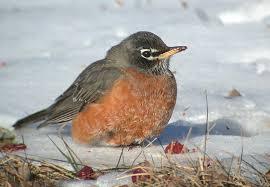
The warm weather wasn’t here yet, not even close; but all the signs were there that it was just around the corner. Each year when we tapped those maple trees, I knew that spring was not far away. It was only a matter of time now that she’d be coming up the Third Line, with all of her delicate shades of green. She’d be bringing her warm sun, and her gentle breezes. She’d slip into our yard quietly one morning, and tell all of the flowers to wake up, and show their colours. She’d whisper to the squirrels and the chipmunks, and invite them to come back and play in our yard.

I often wondered if spring could see us tapping our trees, and if that was her signal to make her way back into Lanark County, and into our yard. Maybe there was something magical about the syrup, and once we’d had our first taste, Old Man Winter knew that it was time for him to pack up his snow, and his cold winds, and head up north. Either way, we always knew that as soon as the sap began to run we’d be seeing spring in all of her glory in no time at all!
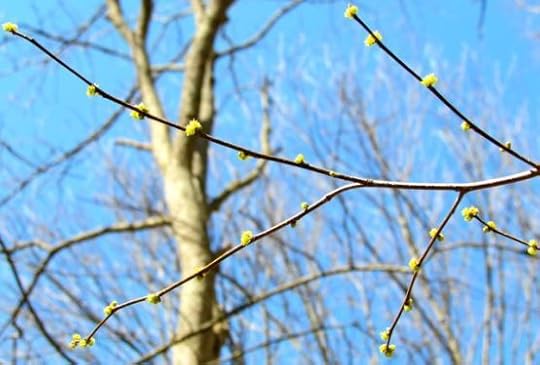
Sweet memories among the maples!
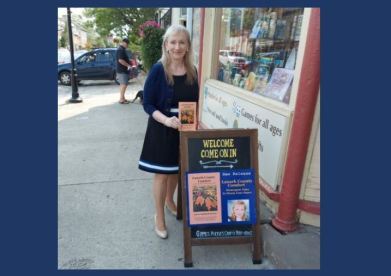
Arlene Stafford-Wilson
Member, Association of Professional GenealogistsHonorary Life Member, Lanark County Genealogical SocietyLanark County Pioneer Families Humanitarian AwardAuthor of : “Lanark County Christmas”, “Lanark County Comfort”, “Lanark County Collection”, “Lanark County Calling”, “Lanark County Classics”, “Lanark County Connections”, “Lanark County Calendar”, “Lanark County Chronicle”, “Lanark County Kid”, & “Recipes & Recollections” and “Lanark County Kitchen: A Maple Legacy from Tree to Table”.March 16, 2024
Drummond Pioneer Irish Boxty

Many of the early settlers in Lanark County, arrived in 1816, like our pioneer ancestor, Tobias Stafford. He came from County Wexford, married the lovely Elizabeth ‘Betsy’ McGarry, from County Westmeath, and after a year spent living on Stafford Island, built a home on Lot 10, 11th Concession of Drummond Township.
One of the recipes brought from their native southern Ireland, was for Irish Boxty. It was a simple dish, made with ingredients on hand. In those days, it was a very long trip by horse and buggy to Perth, for supplies. Many of the early recipes relied on staples, ingredients available in the cupboard, at home.
As some may already know, the Irish love their limericks, and poems, and there is a little rhyme about Boxty, that was often recited with a wink and a smile. Although it is not very politically-correct in these times, it gives us a glimpse into the things of the past, that were popular in the early days:
“Boxty on the griddle,Boxty in the pan,
If you can’t make boxty,
You’ll never get your man”
Recipe for Boxty/ Irish Potato Cakes
2 c mashed potatoes
1 Tbsp flour
2 Tbsp milk
1 Tbsp grated onion
1 egg, beaten
Mix all ingredients together, shape into patties, and fry in a greased pan, until golden brown. (salt and pepper to taste) Serve with eggs, breakfast meats, and hot buttered toast.

(enjoy with a cup of hot Irish breakfast tea, or hot black tea, as our parents did)

This old recipe, in its simplicity, may not be diverse enough for the modern palate, and some may wish to add spices or vegetables into the mix.
Mother and Dad enjoyed plain food that wouldn’t upset their stomachs, and this certainly fits the bill.
and…never to be forgotten, the ritual that always came before any meal at the Stafford home, was the grace:
“Heavenly Father,
Bless this food to our use,
and us, for thy service”
Amen

………….
For more information on the early Irish settlers of Drummond Township, and St. Patrick’s church:
St. Patrick’s Church, Drummond Township
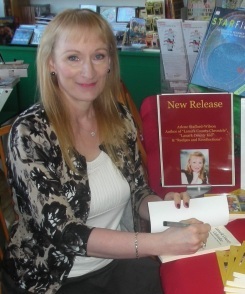
Arlene Stafford-Wilson
Member, Association of Professional GenealogistsHonorary Life Member, Lanark County Genealogical SocietyLanark County Pioneer Families Humanitarian AwardAuthor of : “Lanark County Christmas”, “Lanark County Comfort”, “Lanark County Collection”, “Lanark County Calling”, “Lanark County Classics”, “Lanark County Connections”, “Lanark County Calendar”, “Lanark County Chronicle”, “Lanark County Kid”, & “Recipes & Recollections”, and “Lanark County Kitchen: A Maple Legacy from Tree to Table”This recipe is from “Recipes and Recollections: Treats and Tales from our Mother’s Kitchen” ISBN: 9780987-7026-09

March 15, 2024
St. Patrick’s Church, Ferguson’s Falls, Lanark County
In 1856 St. Patrick’s church was erected in Ferguson’s Falls, on land donated by the Quinn family. The lumber for the church construction was cut from the farm of William Scanlan.
It is one of the oldest Catholic missions in Ontario, and two of its own members joined the priesthood: Father Michael Stafford, son of pioneer Tobias Stafford and Elizabeth McGarry entered the priesthood in 1858. Also Reverend Edmund Quinn, son of John Quinn and Anna Byrnes entered the priesthood in 1947.
Before St. Patrick’s was built, the local Roman Catholics had to travel to St. John’s Church in Perth, which was a long, difficult journey by horse and buggy, particularly in the long, harsh winter months.
This photograph above shows my brother Roger Stafford entering the grounds of the cemetery at St. Patrick’s, July 4th 2012. Many of the early Roman Catholic pioneers are buried in this cemetery. Stafford, Richards, Quinn, McGarry, Foley, Holliger, McKittrick, Blair, Carberry, Kehoe, McCaffrey, to name a few.
……………………………………………………………………………………………………………………………………………….
The Tale of the Seven BachelorsThere were seven young bachelors who left Ireland at the same time, and during their voyage across the ocean they swore that they would stick together, and help each other in their new country. They pledged to stay only if they could carve out a life for themselves, and if not, they swore they would all leave together and return to Ireland.
The Irish bachelors were Patrick Quinn, John Quinn, James Carberry, William Scanlan, Terrence Doyle, John Cullen and James Power.
The bachelors cleared about ten acres of land about two miles from Ferguson Falls, and lived together in a rough log cabin that they had built together. They were given 200 acres of land each, in connecting sections, and each cleared their land and began to farm. They married local girls, and started families. The area where they lived was known as the Quinn Settlement. The story of the Seven bachelors was passed down through the generations.
(The story of the Seven Bachelors was shared with me on two occasions by two local lads, both were raised in the area – from James ‘Jim’ Quinn in 1998, and from my cousin Thomas Stafford in 2001. My Great Aunt Clara Richards married Tom Carberry – a descendant of one of the seven bachelors – James Carberry)………………………………………………………….
112 Years of the St. Patrick Mission in Ferguson Falls – written in 1968One week before Christmas, December 19th, 1968, “The Perth Courier” published an article celebrating the 112th Anniversary of St. Patrick’s Church.

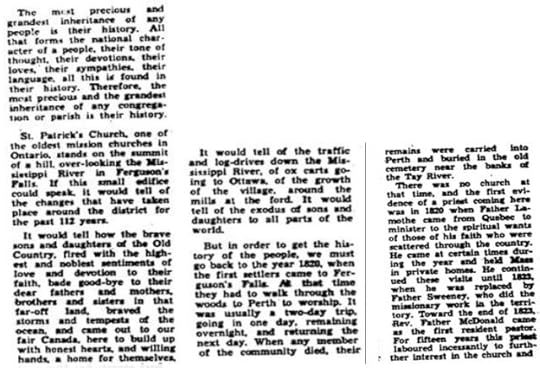



On September 3, 1858, Father McDonagh recorded his Dedication of St. Patrick’s church in the parish register of St. John’s R.C. Church in Perth, Ontario:
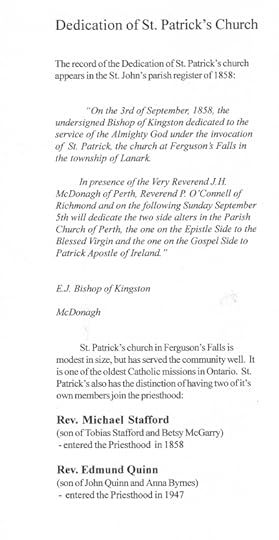
………………………………………………………………………………………………………
Patrick, Apostle of IrelandThe tiny country church in Ferguson Falls was “dedicated to the service of Almighty God, under the invocation of St. Patrick.”
Patrick was a 5th century Christian missionary, and is the primary patron saint of Ireland. Early records show that Patrick was the first Bishop in Ireland, and is regarded as the founder of Christianity. It is said that Patrick converted the Druids to Christianity by using the clover, a plant which grew in abundance all over Ireland, to explain the concept of ‘the Father’, ‘the Son’, and ‘the Holy Spirit’.
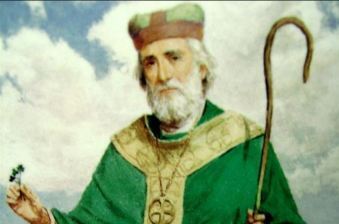
March 17th is known as the ‘Feast of St. Patrick’, celebrated around the world to mark the date that St. Patrick died. The day is marked by church services, and the wearing of green to symbolize the clovers or shamrocks implemented by St. Patrick, to teach the concepts of Christianity. Historically, the restrictions of Lent such as eating and drinking alcohol were put aside for the day, which in recent years gave way to the tradition of alcohol consumption as part of the celebration.

The Celtic Cross (below) was often used in the grave stones and monuments of the settlers who had come from Ireland, like those who attended St. Patrick’s Church in Ferguson Falls.
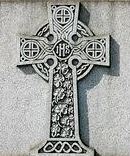
……………………………………………………………………………………………………………………………………………………
Quinn Family of Ferguson FallsThese members of the Quinn family are direct descendants of the pioneer Quinn family who donated the land for St. Patrick’s R.C. Church
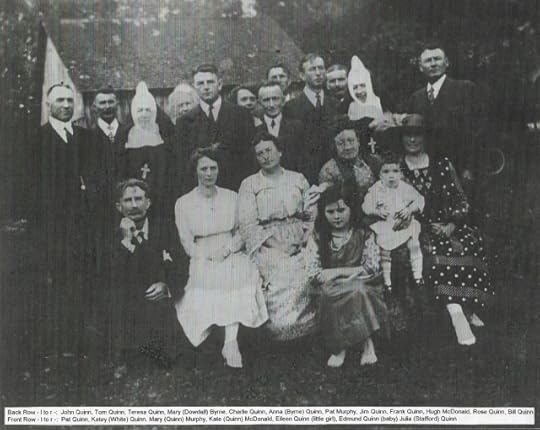
(first member of the congregation to enter the priesthood)
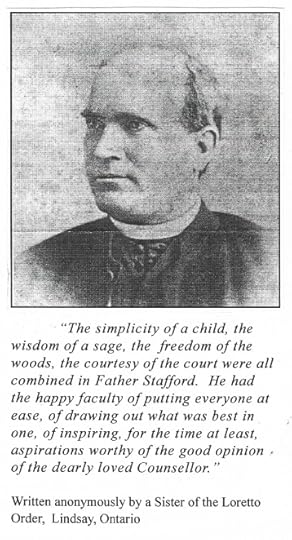
Michael Stafford was born March 1, 1832 in Drummond Township, and died November 12, 1882, age 51 at Lindsay, Ontario. He is interred at St. Mary’s Cemetery, Lindsay, Ontario.
(Older brother to my Great-Grandfather Thomas, Father Michael Stafford was my Great-great Uncle)…………………………………………………………………………………………………………………………
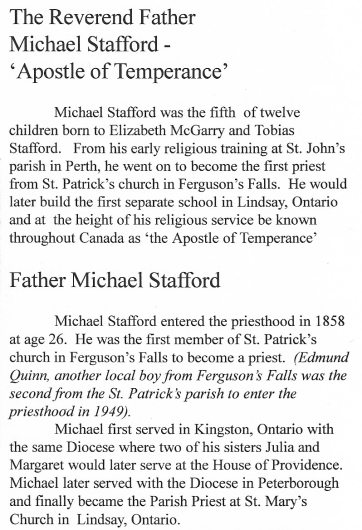
………………………………………………………………………………………………………………………………….
Priests Who Served at St. Patrick’s ChurchFerguson FallsFather McDonagh 1858-1866
Rev. Dr. Chisholm 1866-1878
Rev. John O’Connor 1878-?
Fr. Michael O’Donoghue ?-1889
Fr. M. O’Rourke 1889-1907
Father Keaney 1907-1912
Rev. Father R.A. Carey 1912-1925
Father Eugene O’Sullivan 1925-1928
Father Walter Whelan 1928-1934
Father J.G. Clancy 1934- 1941
Father Walter Healey 1941-1947
(Fr. Healey designed the cobblestone cross that stands in the center of St. Patrick’s Cemetery)
Father Harold Rice 1947-1950
(following Father Rice’s death in 1950, the parish was under the charge of Rev. Brennan for two months)
Rev. Fr. Edward Trainor 1950-1956
Rev. Father Francis Meagher 1956-1959
(after the death of Fr. Meagher, Rev. Fr. Neal administered the parish for one month)
Rev. Fr. Joseph Healey 1959-1967
Rev. Fr. Edward Keyes 1967-1975
……………………………………………………………………………………………
Several women from the Ferguson Falls parish chose to serve the Church, at the House of Providence in Kingston, Ontario

Julia was the daughter of pioneer Tobias Stafford and Elizabeth ‘Betsy’ McGarry Stafford. Three members of this family devoted their lives to the divine service: Rev. Father Michael Stafford, who was parish priest of Lindsay at his death in 1882, and Julia and Margaret, exemplary members of this Institute.
Julia entered the House of Providence in Jan. 1868. She enjoyed working with children and preparing them for first communion. She also worked to keep the wayward on the straight and narrow, and to bring the sacraments to adults whose early education had wandered from their religious duties. She taught an evening class of adults, In the early spring each year many of these poor fellows would be prepared for Confirmation and presented to His Lordship. To protect them against the voice of intemperance to which sailors are inevitably exposed, she would persuade them to take the “pledge” before setting off on their perilous journeys, she gained a sense of satisfaction when they pledged to keep their promise. In a work so noble Julia strongly resembled her Rev. Brother Michael Stafford, who was deservedly styled the “Apostle of Temperance in Canada.”
………………………………………………………………………………………………………………………………………..
Sister Mary ElizabethMargaret Stafford 1845-1925
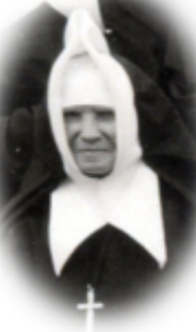
Sister Mary Elizabeth, or as she was known in the world, Margaret Stafford, was descended from a strong Irish Catholic family. Her father and mother, Tobias and Elizabeth (McGarry) Stafford, in the Township of Drummond, in the Parish of Perth. She had several brothers, one, the Reverend Michael Stafford of the Kingston diocese, and later of Peterborough, was a great temperance lecturer and won the appellation of “a second Father Matthew”. Her younger sister, Sister Mary Vincent, who entered the Community a year or more before, predeceased her several years. Like all the family Sister was of a very large build, tall and strong. Her very appearance would command respect at any time or place.
Born February 22, 1845, she entered the Novitiate at the age of 23 on November 21, 1868. She seemed very much older. She received the Holy Habit Dec. 13, 1869, and made Holy Profession May 31, 1871.
In 1888 she was given charge of the men’s department. She took complete charge of the apartment. She ruled as one having authority. There was no questioning, no back answers or insulting words would be tolerated. There was a rule to be observed and it must be followed. The time of rising and retiring had to be observed strictly. Although she was strict, she was very kind. If anyone was sick or in trouble, she was always there to help. As a result she was loved and respected by all.
Margaret Stafford (Sister Mary Elizabeth) passed away on St. Patrick’s Day, 1925.
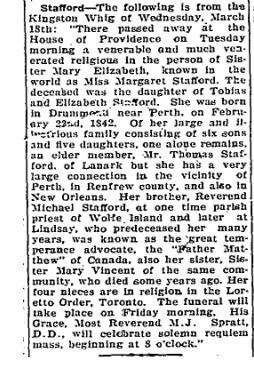
…………………………………………………………………………………………………………………………………………………….
Sister Mary JamesTheresa Quinn 1878-1949
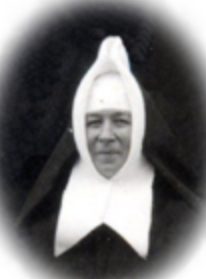
The former Theresa Quinn, born in Ferguson’s Falls, was one of a large family of boys and girls, including Sister Mary. Edward. She entered the Novitiate, on September 8, 1905. She served the church in Smiths Falls, Brockville and Lancaster. She was one of the original members of Rosary Hall, our first foundation in Edmonton, Alta. and spent her remaining years 1905-1949 caring for the sick at the House of Providence in Kingston.
Sister M. James was faithful at all times, devoted to her work in the care of the aged and infirm brought comfort and joy into the lives of others by her cheerful nature.
………………………………………………………………………………………………………………………………………….
Sister Mary Hilda Quinn
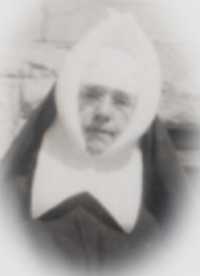
Sister Mary Hilda (Clara A. Quinn), born in Ferguson’s Falls, Ontario, Educated at Lanark, taught school for one year, then entered the Novitiate of the Sisters of the House of Providence in Kingston in January of 1907, at the age of 19. She graduated from Queen’s University in 1924 with a Bachelor of Arts. She taught school in Belleville and Chesterville for a total of 42 years, 17 of which were as the Local Superior of the Convent. Her motto for her students, which she wrote on her chalkboard: “That they may have life and may have it more abundantly.”
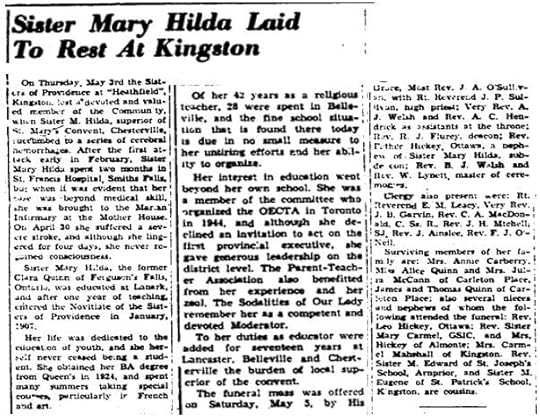
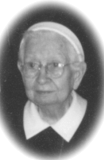
Sister Mary Edward (Rose Mary Quinn) was a descendent of one of the pioneer families who emigrated from Ireland in the early years of the nineteenth century and settled in Ferguson’s Falls. Bishop MacDonell, the first Bishop of Upper Canada, first offered Mass in the Quinn home when he visited the remote missions of his large diocese. Sister Mary Edward’s parents, James Quinn and Elizabeth McNaughton, raised eleven children and three of the children were called to serve the church: Sisters Mary James and Sister Mary Edward, and a grandson, Rev. Edmund Quinn.
Rose Mary Quinn was educated in the local school, then attended Lanark High School and Ottawa Teachers’ College. She entered the Novitiate at St. Mary’s of the Lake on August 15, 1913, and taught in various schools in Portsmouth; St. John’s, Kingston; Smiths Falls; St. Mary’s, Kingston; Tweed and for thirteen years at St. Michael’s, Belleville. In 1946 she was appointed to Arnprior in Pembroke diocese, where in 1959 she completed a teaching career of almost fifty years.
…………………………………………………..
Ferguson Falls – Early SettlementOriginally known as Millford, Fergusons Falls was renamed in honor of the early settler Captain Ferguson when a post office was established there. This was the closest village to the Stafford farm on the 11th concession of Drummond, and was a source for supplies, postal services, blacksmith services, social activities, and later St. Patrick’s Roman Catholic Church.
Thomas McCaffrey was the first settler, arriving in 1815. McCaffrey was a good friend of Tobias Stafford and Elizabeth ‘Betsy’ (McGarry) Stafford. Thomas was one of the witnesses to their marriage ceremony in St. John’s Church in Perth. He also signed his name as witness to one of Tobias’ later land transactions, and was present at the baptisms of some of the Stafford children.
The Forces of NatureThe early settlers not only faced the challenges of clearing heavily-wooded land, building a home, and providing for their growing families; they also dealt with hot summers, and cold winters. Some years had wet conditions, and some years they dealt with drought. As if that wasn’t enough to cope with; there were the storms…..
The Cyclone of June, 1888
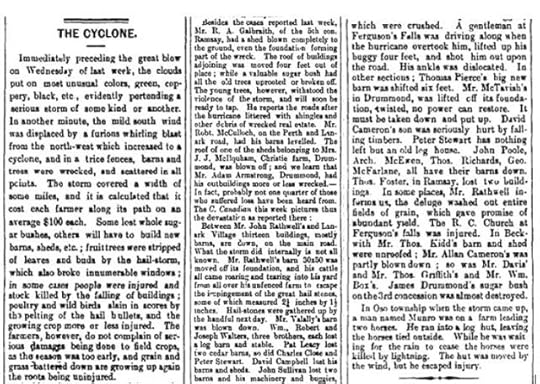
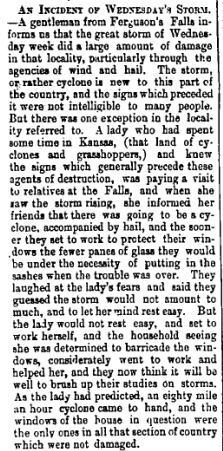
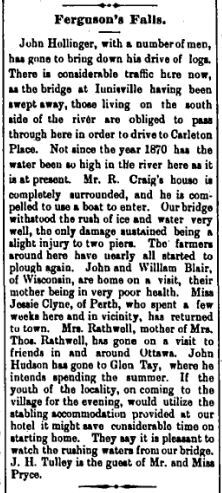
Violent thunderstorms caused damage and sometimes total destruction to homes, barns and precious livestock. In the summer of 1897 Ferguson Falls farmer Thomas Haley nearly died trying to save his horses, when lightning struck his barn.
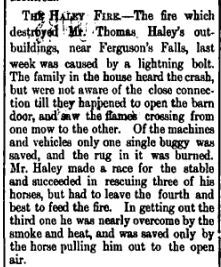
In June of 1921 Ferguson Falls experienced a terrible heat wave, lasting more than three weeks.
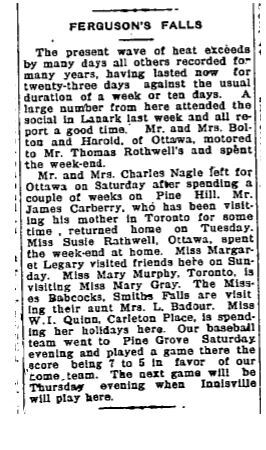
…………………………………………………………………………………………………………………………………………………….
Ferguson Falls Stories and LegendsThe Ghost of Jimmy Whelan
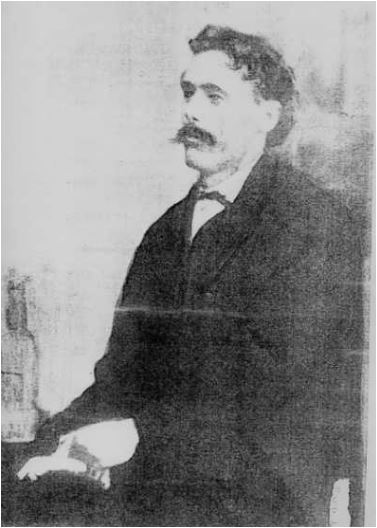
There are conflicting stories about a logging accident in Drummond Township that took the life of Jimmy (Phelan?) Whalen. Some say the accident took place in 1876, and some say 1878. What can be agreed upon is that Jimmy died as a result of trying to break up a log jam.
Log driving was a popular occupation for spry, young men, who were agile enough to leap from log to log, or to coast down the river while keeping their balance on such a precarious vessel.
A poem was written, and later sent to music, describing the ghost of Jimmy Whelan, and how he appeared to his lady-friend as she walked along the river bank.
Lost Jimmy Whelan
All alone as I strayed by the banks of the river,
Watching the moonbeams as evening drew nigh,
All alone as I rambled, I spied a fair damsel
Weeping and wailing with many a sigh.
Weeping for one who is now lying lowly,
Mourning for one who no mortal can save.
As the foaming dark water flow gently about him,
Onward they speed over young Jimmy’s grave.
She cries, “Oh, my darling, please come to me quickly,
And give me fond kisses that oft-times you gave.
You promised to meet me this evening, my darling,
So now, lovely Jimmy, arise from your grave.”
Slowly he rose from the dark, stormy waters,
A vision of beauty more fair than the sun,
Saying “I have returned from the regions of glory
To be in your dear loving arms once again.”
“Oh, Jimmy, why can’t you tarry here with me,
Not leave me alone, so distracted in pain.”
“Since death is the dagger that’s cut us asunder,
Wide is the gulf, love, between you and I.”
“One fond embrace, love, and then I must leave you;
One loving farewell, and then we must part.”
Cold were the arms that encircled about her;
Cold was the body she pressed to her heart.
Slowly he rose from the banks of the river,
Up to the heavens he then seemed to go
Leaving this fair maiden, weeping and mourning,
Alone on the banks of the river below.
…………………………………………………………………………………………
From a letter written in 1923, by Mr. Christopher Forbes, of Perth, Ontario:“The Phelan family live in this district. The name is pronounced ‘Whalen’, locally. James’ brother Thomas, whom I knew intimately, died a few years ago. Regarding the James Phalen tragedy, John Smith of Lanark Village, an old timer and singer of the ‘come all ye’ type, wrote the words which I now enclose. He sings the Jim Whalen song with much pathos, and with that peculiar dropping off of the last word from a singing tone to a speaking voice. This style of finishing a song is used by sailors and shanty-men.
I was fortunate in meeting an old shanty foreman, Peter McIlquham, well known on the Mississippi River for over half a century, who told me he was present at Jim Whelan’s death.
It happened 45 years ago (1878), at King’s Chute, on the Mississippi River. Whalen was a river-man under ‘Old Quebec’, a French-Canadian whose real name was Edward Leblanc. McIlquham was also a foreman on the river at this time. Both rafts of longs had come out of Crotch Lake by the river-men. McIlquham came to assist Old Quebec putting over King’s Chute. A dangerous and difficult jam formed in the Chute. ‘Old Quebec’, McIlquham, and Phalen were close together when the jam shifted, and precipitated Phalen into the water.”
………………………………………………………………………………………….
Like the tale itself, there are two different authors given credit for writing the song – Tim Doyle of Drummond Township, and John Smith of Lanark.”
…………………………………………………………………………………………..
Stumble InnThe infamous ‘Stumble Inn’ was one of the three hotels in Ferguson Falls, located right on the shore of the Mississippi River, and is said to be one of the oldest buildings in the village. According to the lads who grew up in the area it was ‘the’ place to stop for a drink, before or after mass at St. Patrick’s Church. During the week, local men often gathered there to play cards in the evening, and on the weekends, helped along by a little (or a lot) of alcohol, there was singing, dancing and fiddle-playing. The Stumble Inn was also notorious for its fights, and it wasn’t uncommon for one or two of the lads to end up in the river before the evening was over.
………………………………………………………………………………………………………………………………………………..
Education –The School at Ferguson FallsS.S. # 8 LanarkThe original log school house was built around 1820, replaced with another log building in 1871, which was eventually constructed with bricks. The school remained open until 1968. That was the year when all students of the small, one-room school houses in Lanark County were sent to larger more centralized schools.
Results of the Ferguson Falls School Exam – school year 1868-1869:

In the late fall of 1888 the little school at Ferguson Falls lost one of its most beloved teachers Jennie Doyle:
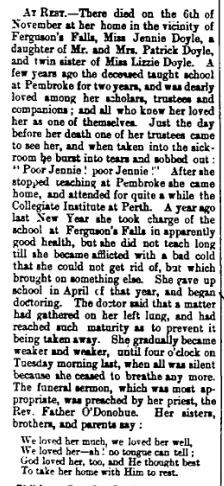
Death Certificate of Ferguson Falls teacher Jennie Doyle, age 22.
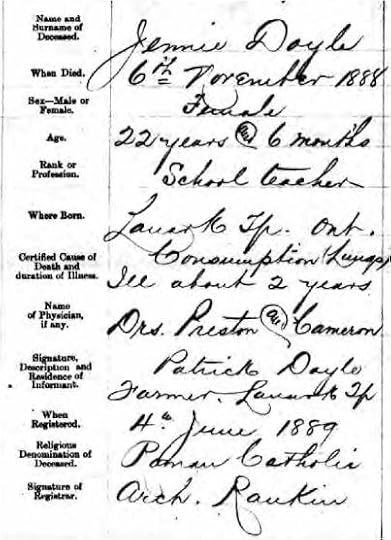
It wasn’t always easy to find a good, reliable teacher for the tiny school at Ferguson’s Falls. Below, is an ad that was placed in November of 1891. My Great-grandfather, Thomas Richards, served as one of the School Trustees.
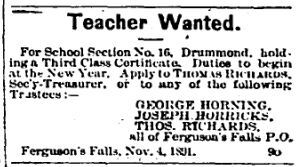
In November of 1893, my Great Aunt Mary Stafford was hired to teach at the little school. The article also mentions one of the Hollinger lads who had accidentally shot himself in the leg. Apparently there were some thieves in the area stealing livestock. The last mention is of Mary Stafford’s father Thomas driving his herd of lambs through the village, likely on his way to Carleton Place where they were put up for auction, or shipped by train across Canada or into the U.S. Some livestock were even loaded on ships and sent overseas to England.

Another column, from November 13, 1896, highlights some of the activities taking place at that time in the village.
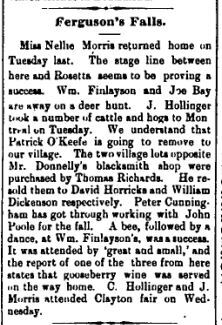
The school Honour Roll – 1896
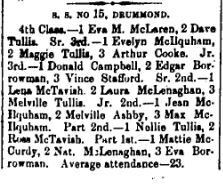
A news column from December of 1897 mentions teacher, Mary Kehoe, and her plans for her Christmas vacation. Also interesting is that the local businesses have decorated their storefronts for the Christmas season. Near the end of the column is a mention of a “disgraceful scene” on the street on the previous Saturday evening, then a veiled reference which may or may not apply to one of the local Doyle lads who would have been living in the area at that time.
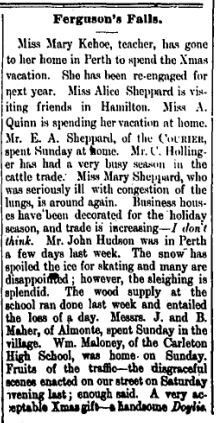
In February of 1898, Sarah Ferguson was listed as the teacher at Ferguson Falls:
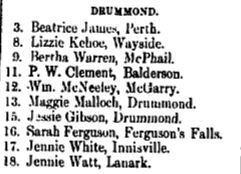
A porch was added to the Ferguson Falls schoolhouse in the fall of 1899
from an article printed – March 23, 1900:
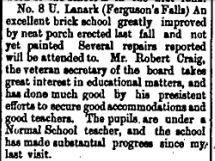
By 1909, Margaret Doyle was the teacher at the little school in Ferguson Falls:
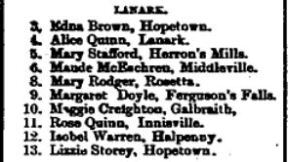
Results from the Lanark Entrance Exams of 1925:
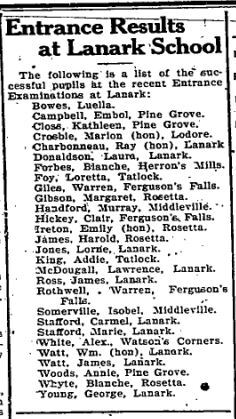
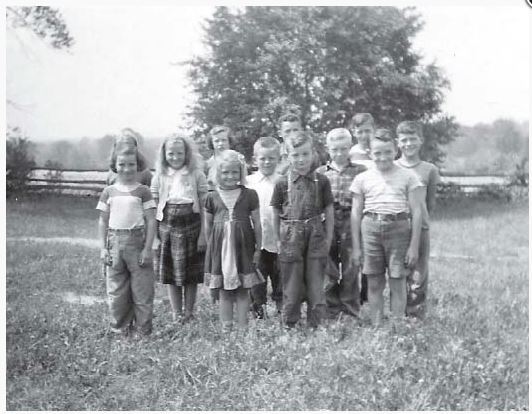
1951 Back row: Janet Hollinger, Arthur Forrest, Charles Hollinger, John Hollinger Middle row : Marion Gilles, Brian Rothwell, Ken Ruttle Front row: Marjorie Murphy, Doris Gilles, Leonard Murphy, Bert Forrest
………………………………………………………………………………………………………………………………………
CommerceBy 1857, Ferguson Falls was booming. More than 400 people lived in the village. John Doyle was the Innkeeper, James McCaffrey was listed in the business directory as a Wagon Maker, John & M. McCaffrey were the local Blacksmiths. John Stafford, (Tobias Stafford and Elizabeth McGarry’s son) was the area Shoemaker, and would later open a shoe store in Almonte, then in Perth. There was also a sawmill, and a grist mill owned by Robert Blair and a hotel owned by Charles Hollinger.
Mississippi Cheese Factory – 1890
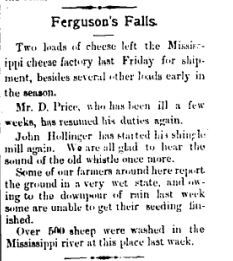
In 1909 the first telephone line was installed to serve the community around Ferguson’s Falls.

Robert Blair built a dam across the Mississippi River which created the ‘falls’, in order to provide power for his two mills. As time went on, local lore tells that the water from the river backed up along the banks because of Blair’s dam, and caused flooding of the lowlands for the farmers located upstream. Eventually the dam was taken down.
There were many issues over the years, some even resulted in legal action between residents of the area -like the case between Playfair and Blair in April of 1865:
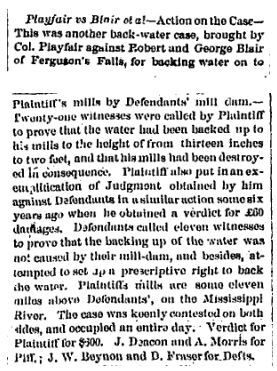
Problems with the dam continued, and several letters like the one below, were sent to the Editor of ‘The Perth Courier’ in the summer of 1870:
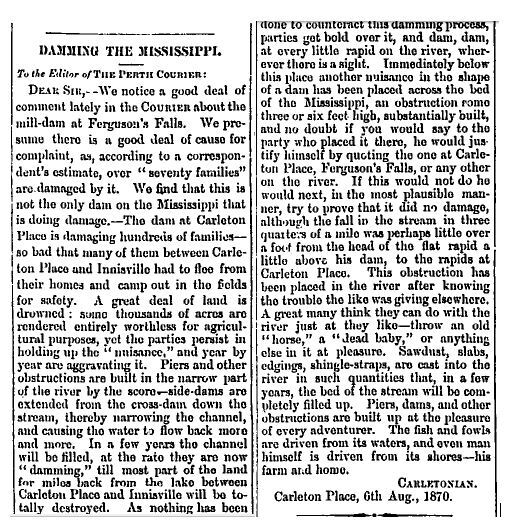
At one time there were three hotels at Ferguson Falls to provide accommodation to travelers passing on their way to Perth or Renfrew. The Log-Drivers who worked on the Mississippi were frequent visitors to the hotels. It’s been said that the floor at Charles ‘Charlie’ Hollinger’s Hotel had to be replaced each year due to the Log-Drivers dancing on the wooden surface, in their spiked logging boots.
In 1890 Mrs. John Murray advertised her hotel for sale in the local newspapers.
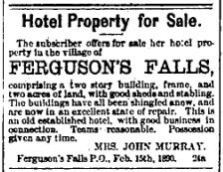
Hollinger -Nagle Wedding 1875
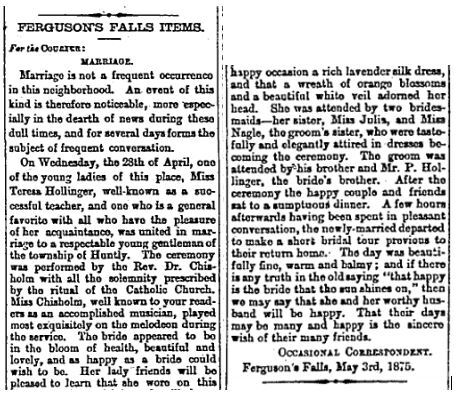


Hollinger sisters of Ferguson’s Falls – taken c. 1900 in Perth, Ontario
Left to Right: Elizabeth Hollinger, seated. Theresa Hollinger is standing, second from the left. Julia Hollinger McGarry is seated, and standing at the far right is Maria Hollinger.
(daughters of Charles Hollinger and Elizabeth Cokely)
There were also three brothers – Charles, John and Patrick
……………………………………………………………………………………………………………………………………………….
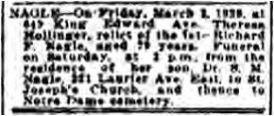
Theresa Hollinger Nagle – obituary from ‘The Ottawa Journal’ Friday, March 2, 1928.
………………………………………………………………………………………………………………………………………………….
July 1897 – news from ‘the Falls’
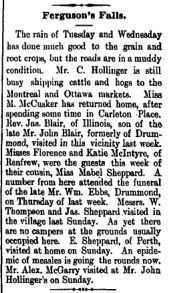
McDonald-Quinn Wedding June 7, 1909
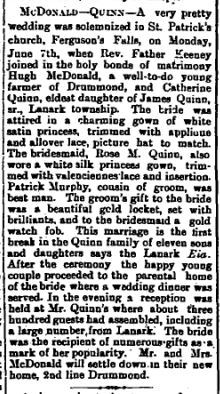
Obituary for Mrs. John Rathwell (March 1893)
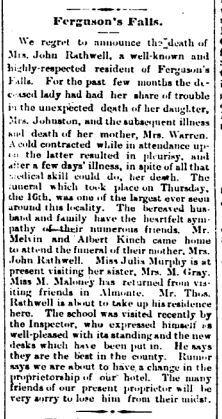
Murphy – Stafford Courtship Begins!
In the fall of 1893, a dance was held – ‘Murray’s Ball’ – a very successful event, and it was during this time that my grandfather’s older brother Peter Stafford began to date the lovely Miss Mary Murphy. They would later marry, and have a large family. Peter was a stagecoach driver, and had a little ‘taxi’ service where he transported local folks back and forth between Perth and Lanark, and places in the surrounding area.
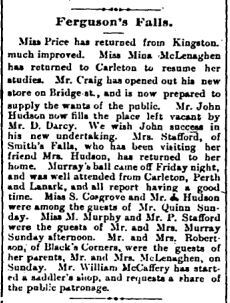
Closs-Vallely Wedding
In June of 1894 a lovely summer wedding took place at St. Patrick’s when Alice Closs married Anthony Vallely, ceremony performed by Father O’Rourke.
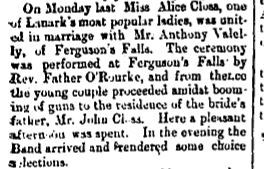
Sullivan- Brady Wedding – May 1895

Hollinger Obituary – 1906 – long-time Postmaster in Ferguson Falls
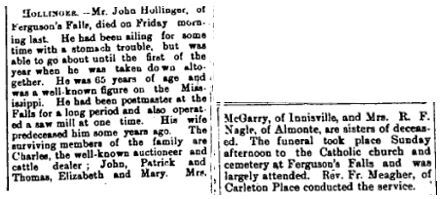
McGarry Obituary – 1912 – owned the McGarry Hotel in Innisville
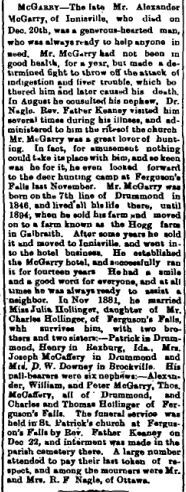
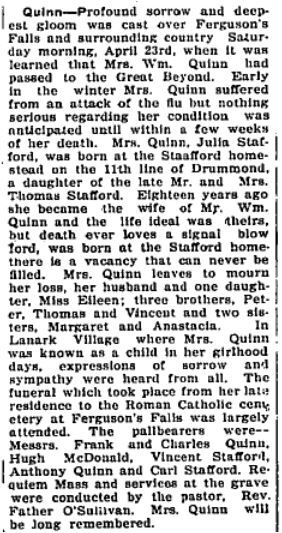
……………………………………………………………………………………………………………………………………………..
If you’re in the area…………….St. Patrick’s Roman Catholic Church is set in a picturesque location, not far from the mighty Mississippi, and is a lovely spot to visit, and to reflect, on a warm, sunny day.
We remember those who came before us, stood on these very grounds, celebrated baptisms and weddings, and mourned the loss of their loved ones at the funerals held at this small country church.
It is well worth a visit for anyone with local connections, to spend some time at this historic and sacred place in Ferguson’s Falls.
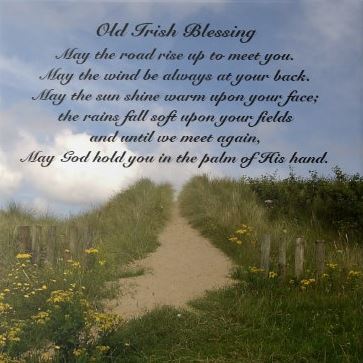
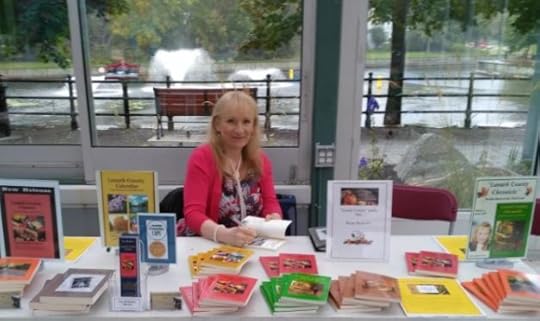
Arlene Stafford-Wilson
Member, Association of Professional GenealogistsHonorary Life Member, Lanark County Genealogical SocietyLanark County Pioneer Families Humanitarian AwardAuthor of : “Lanark County Christmas”, “Lanark County Comfort”, “Lanark County Collection”, “Lanark County Calling”, “Lanark County Classics”, “Lanark County Connections”, “Lanark County Calendar”, “Lanark County Chronicle”, “Lanark County Kid”, & “Recipes & Recollections”, and “Lanark County Kitchen: A Maple Legacy from Tree to Table”http://www.staffordwilson.com

